-
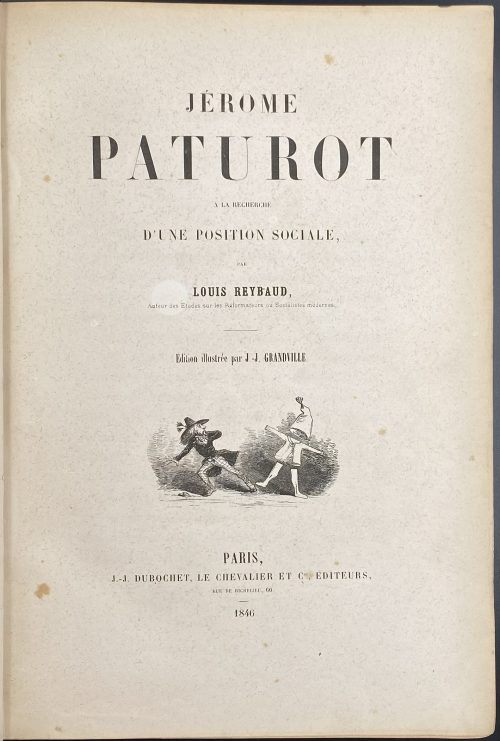 4to volume, ‘cartonnage percaline romantique’, 27.5 x 19.5 cm, green cloth with gilt fillet border and fictional coat of arms to front, border and fleuron to back, gilt and embossed vignette to spine, yellow endpapers, all edges gilt, 32 plates, incl. frontispiece, with tissue guards, and numerous in-text woodcuts after J.-J. Grandville by various engravers, mostly by Best, Leloir, Hotelin et Régnier group. Page 102 is numbered correctly. Title-page: JÉROME | PATUROT | A LA RECHERCHE | D'UNE POSITION SOCIALE | PAR | LOUIS REYBAUD, | Auteur des Études sur les Reformateurs ou Socialistes modernes. | — | Édition illustrée par J.-J. Grandville. | {vignette} | PARIS, | J.-J. DUBOCHET, LE CHEVALIER ET Cie, ÉDITEURS, | RUE DE RICHELIEU, 60. | – | 1846 || Collation: π4 1-574 582; total 234 leaves plus 32 wood-engraved plates extraneous to collation. Pagination: [8] [1] 2-460; total 468 pages, ils. Catalogue raisonné: L. Carteret 516; Ray 197 (pp. 277-8); Brivois: 350-1. Contributors: Louis Reybaud [Jérôme Paturot] (French, 1799 – 1879) – author. J.-J. Grandville [Isidore-Adolphe Gèrard] (French, 1803 – 1847) – artist. Schneider et Legrand (Paris) – printer. J.-J. Dubochet, Le Chevalier et Cie – publsiher. Engravers: Lucjan Stypulkowski (Polish, 1806 – 1849) Best, Leloir, Hotelin et Régnier Jean Baptiste Best (French, 1808 – 1879) or Adolphe Best (French, 1808 – 1860) Isidore Leloir (French, 1806 – 1851) Laurent Éloi Hotelin (French, 1821 – 1894) Eugène Laurent Isidore Régnier (?)
4to volume, ‘cartonnage percaline romantique’, 27.5 x 19.5 cm, green cloth with gilt fillet border and fictional coat of arms to front, border and fleuron to back, gilt and embossed vignette to spine, yellow endpapers, all edges gilt, 32 plates, incl. frontispiece, with tissue guards, and numerous in-text woodcuts after J.-J. Grandville by various engravers, mostly by Best, Leloir, Hotelin et Régnier group. Page 102 is numbered correctly. Title-page: JÉROME | PATUROT | A LA RECHERCHE | D'UNE POSITION SOCIALE | PAR | LOUIS REYBAUD, | Auteur des Études sur les Reformateurs ou Socialistes modernes. | — | Édition illustrée par J.-J. Grandville. | {vignette} | PARIS, | J.-J. DUBOCHET, LE CHEVALIER ET Cie, ÉDITEURS, | RUE DE RICHELIEU, 60. | – | 1846 || Collation: π4 1-574 582; total 234 leaves plus 32 wood-engraved plates extraneous to collation. Pagination: [8] [1] 2-460; total 468 pages, ils. Catalogue raisonné: L. Carteret 516; Ray 197 (pp. 277-8); Brivois: 350-1. Contributors: Louis Reybaud [Jérôme Paturot] (French, 1799 – 1879) – author. J.-J. Grandville [Isidore-Adolphe Gèrard] (French, 1803 – 1847) – artist. Schneider et Legrand (Paris) – printer. J.-J. Dubochet, Le Chevalier et Cie – publsiher. Engravers: Lucjan Stypulkowski (Polish, 1806 – 1849) Best, Leloir, Hotelin et Régnier Jean Baptiste Best (French, 1808 – 1879) or Adolphe Best (French, 1808 – 1860) Isidore Leloir (French, 1806 – 1851) Laurent Éloi Hotelin (French, 1821 – 1894) Eugène Laurent Isidore Régnier (?) -
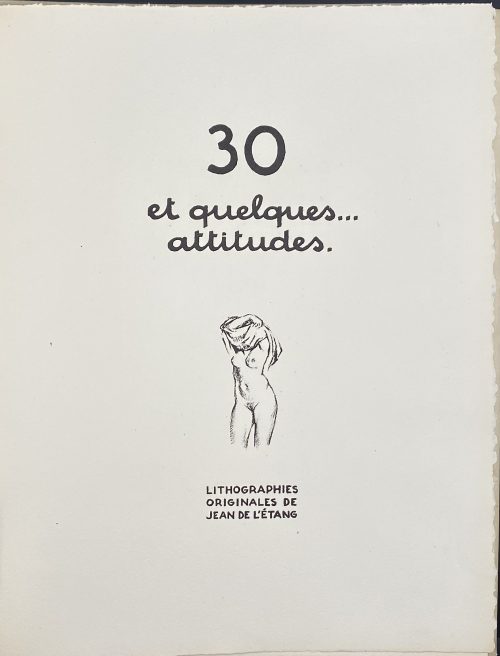 Title-page: 30 | et quelques… | attitudes. | {vignette} | LITHOGRAPHIES | ORIGINALES DE | JEAN DE L’ÉTANG || Colophon: ACHEVÉ | D’IMPRIMER | EN | M C MLII || Description: Cream French flapped wrappers enforced with cardboard, in a double slipcase, 30.2 x 24 x 4.5 cm, with a lithograph to front and back depicting the female crotch, front and back, respectively. Printed on wove paper watermarked ‘Johannot’ (produced by Arches, France). Unbound; margins untrimmed. Collation: 2 leaves on the front and 2 on the back with two within the wrappers, incl. colophon, 2 leaves: one blank and one t.p. / limitation, 12 loose gatherings of 4 leaves each (48) with glassine interleaving. Pagination: [1-8] 9-102 [2], total 104 pp (leaves in wrappers not counted). Illustrated with 25 full-page lithographs (incl. covers) and 29 smaller images. Artist’s name Jean de l’Étang is most probably a pseudonym attributed by both J.-P. Dutel and Gérard Nordmann to Jean Dulac (French, 1902 – 1968). Limitation: A print run of 200 copies, of which this is copy № 186 (Nordmann's collection had №184). Cat. raisonné: Dutel III №2511, p. 388; Nordmann II №181, p. 89; Honesterotica.
Title-page: 30 | et quelques… | attitudes. | {vignette} | LITHOGRAPHIES | ORIGINALES DE | JEAN DE L’ÉTANG || Colophon: ACHEVÉ | D’IMPRIMER | EN | M C MLII || Description: Cream French flapped wrappers enforced with cardboard, in a double slipcase, 30.2 x 24 x 4.5 cm, with a lithograph to front and back depicting the female crotch, front and back, respectively. Printed on wove paper watermarked ‘Johannot’ (produced by Arches, France). Unbound; margins untrimmed. Collation: 2 leaves on the front and 2 on the back with two within the wrappers, incl. colophon, 2 leaves: one blank and one t.p. / limitation, 12 loose gatherings of 4 leaves each (48) with glassine interleaving. Pagination: [1-8] 9-102 [2], total 104 pp (leaves in wrappers not counted). Illustrated with 25 full-page lithographs (incl. covers) and 29 smaller images. Artist’s name Jean de l’Étang is most probably a pseudonym attributed by both J.-P. Dutel and Gérard Nordmann to Jean Dulac (French, 1902 – 1968). Limitation: A print run of 200 copies, of which this is copy № 186 (Nordmann's collection had №184). Cat. raisonné: Dutel III №2511, p. 388; Nordmann II №181, p. 89; Honesterotica. -
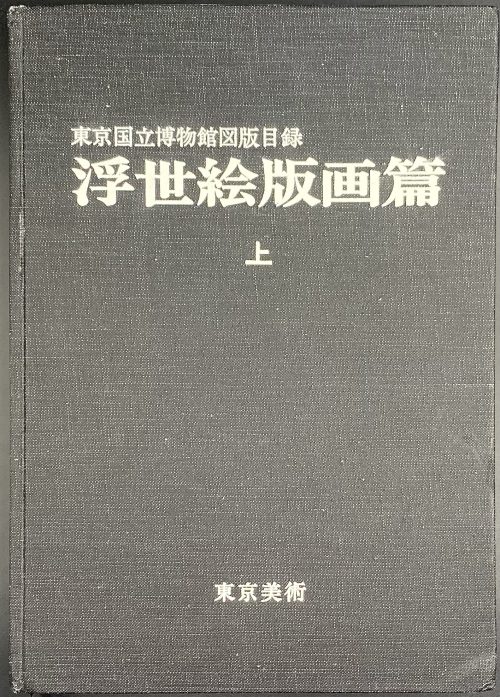 Title: Illustrated Catalogues of Tokyo National Museum: Ukiyo-e Prints [東京国立博物館図版目録 | 浮世絵版画編] (Tōkyō Kokuritsu Hakubutsukan zuhan mokuroku | Ukiyoe hanga hen); Publisher: Tokyo National Museum [東京国立博物館] (Tōkyō Kokuritsu Hakubutsukan). Three volumes, 26.3 x 18.7 cm, uniformly bound in black cloth with white characters to front cover and spine. Title-page: ILLUSTRATED CATALOGUES OF | TOKYO NATIONAL MUSEUM | UKIYO-E PRINTS | <1 (2, 3) > | 東京国立博物館図版目録 | 浮世絵版画編 | < 上 (中, 下) > || Volume 1 [上]: unpaginated 1 t.p., 2 colour plates, 1 contents, 70 (1-1354) – b/w plates, 1 + 48 paginated leaves (1-95 [96]) – text. Volume 2 [中]: unpaginated 1 t.p., 2 colour plates, 1 contents, 67 (1355-2493) – b/w plates + 33 paginated leaves (1-65 [66]) – text. Volume 3 [下]: unpaginated 1 t.p., 2 colour plates, 1 contents, 83 (2494-3926) – b/w plates + 35 paginated leaves (1-69 [70]) – text. Black and white photomechanical reproduction of almost four thousand woodblock prints with titles by the artist and in chronological order.
Title: Illustrated Catalogues of Tokyo National Museum: Ukiyo-e Prints [東京国立博物館図版目録 | 浮世絵版画編] (Tōkyō Kokuritsu Hakubutsukan zuhan mokuroku | Ukiyoe hanga hen); Publisher: Tokyo National Museum [東京国立博物館] (Tōkyō Kokuritsu Hakubutsukan). Three volumes, 26.3 x 18.7 cm, uniformly bound in black cloth with white characters to front cover and spine. Title-page: ILLUSTRATED CATALOGUES OF | TOKYO NATIONAL MUSEUM | UKIYO-E PRINTS | <1 (2, 3) > | 東京国立博物館図版目録 | 浮世絵版画編 | < 上 (中, 下) > || Volume 1 [上]: unpaginated 1 t.p., 2 colour plates, 1 contents, 70 (1-1354) – b/w plates, 1 + 48 paginated leaves (1-95 [96]) – text. Volume 2 [中]: unpaginated 1 t.p., 2 colour plates, 1 contents, 67 (1355-2493) – b/w plates + 33 paginated leaves (1-65 [66]) – text. Volume 3 [下]: unpaginated 1 t.p., 2 colour plates, 1 contents, 83 (2494-3926) – b/w plates + 35 paginated leaves (1-69 [70]) – text. Black and white photomechanical reproduction of almost four thousand woodblock prints with titles by the artist and in chronological order. -
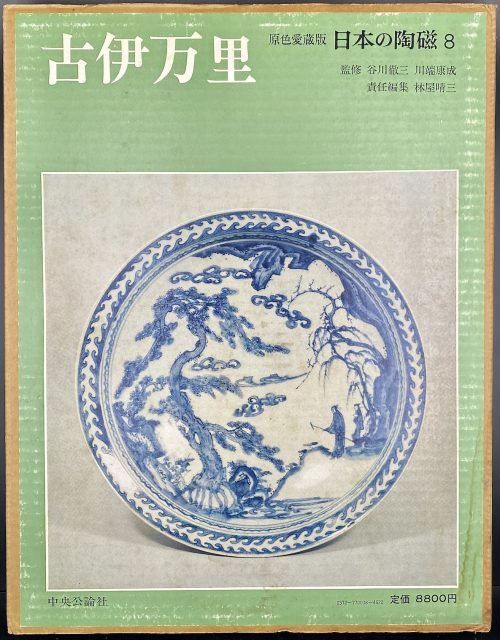 Hardcover volume, 35.1 x 27 cm, bound in grey cloth, blind stamped characters to front, brown characters to spine, in a glassine dust jacket, in a double slipcase, the outer case pictorial paper over cardboard, 36 x 27.8 cm, pp.: [4] [1] 2-108 (plates with photographs of 217 items), [2] [111] 112-150 [3]. Imari ware [伊万里焼] (Imari-yaki) – ceramics produced in and around the area of Arita, in the former Hizen Province, northwestern Kyūshū. 日本の陶磁 – Japanese ceramics, series title. Old imari [古伊万里] (koimari) – book title. Contributors: Yasunari Kawabata [川端 康成] (Japanese, 1924 – 1972) – author. Tetsuzo Tanikawa [谷川 徹三] (Japanese, 1895 – 1989) – author. Seizo Hayashiya [林屋晴三] (Japanese, 1928 – 2017) – editor. Chūōkōron-sha [中央公論社] – publisher.
Hardcover volume, 35.1 x 27 cm, bound in grey cloth, blind stamped characters to front, brown characters to spine, in a glassine dust jacket, in a double slipcase, the outer case pictorial paper over cardboard, 36 x 27.8 cm, pp.: [4] [1] 2-108 (plates with photographs of 217 items), [2] [111] 112-150 [3]. Imari ware [伊万里焼] (Imari-yaki) – ceramics produced in and around the area of Arita, in the former Hizen Province, northwestern Kyūshū. 日本の陶磁 – Japanese ceramics, series title. Old imari [古伊万里] (koimari) – book title. Contributors: Yasunari Kawabata [川端 康成] (Japanese, 1924 – 1972) – author. Tetsuzo Tanikawa [谷川 徹三] (Japanese, 1895 – 1989) – author. Seizo Hayashiya [林屋晴三] (Japanese, 1928 – 2017) – editor. Chūōkōron-sha [中央公論社] – publisher. -
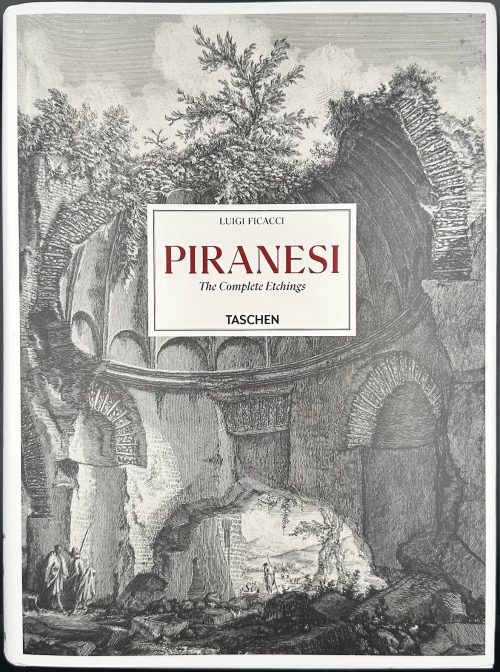 Hardcover volume, 35 x 26 cm, bound in pictorial paper boards with a lettered label to front cover, black lettering to spine, pictorial dust jacket, pictorial endpapers, pp.: [1-5] 6-787 [788], 1028 colour ils., trilingual edition (English, German, French). Title-page (red and black): LUIGI FICACCI | ISTITUTO NAZIONALE PER LA GRAFICA, ROME | Giovanni Battista | PIRANESI | Catalogue of the Complete Etchings | Gesamtkatalog der Radierungen | Catalogue raisonné des eaux-fortes | TASCHEN || Contributors: Luigi Ficacci (Italian, b. 1954) – author. Giovanni Battista [Giambattista] Piranesi (Italian, 1720 – 1778) – artist.
Hardcover volume, 35 x 26 cm, bound in pictorial paper boards with a lettered label to front cover, black lettering to spine, pictorial dust jacket, pictorial endpapers, pp.: [1-5] 6-787 [788], 1028 colour ils., trilingual edition (English, German, French). Title-page (red and black): LUIGI FICACCI | ISTITUTO NAZIONALE PER LA GRAFICA, ROME | Giovanni Battista | PIRANESI | Catalogue of the Complete Etchings | Gesamtkatalog der Radierungen | Catalogue raisonné des eaux-fortes | TASCHEN || Contributors: Luigi Ficacci (Italian, b. 1954) – author. Giovanni Battista [Giambattista] Piranesi (Italian, 1720 – 1778) – artist. -
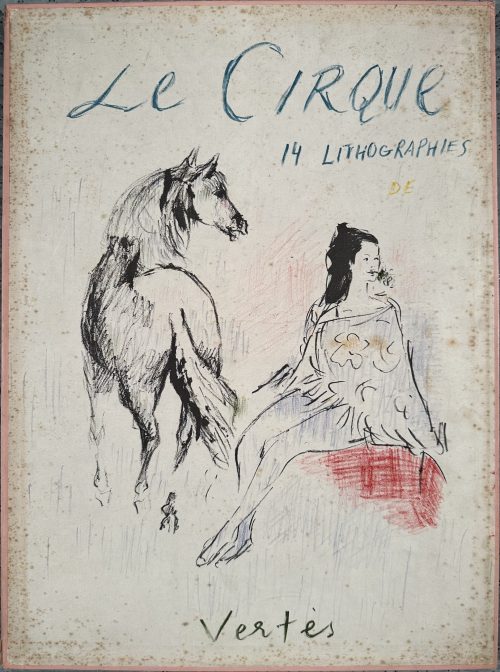 Publisher’s peach cloth box 555 x 410 mm with coloured lithograph on the lid, autographed with crayons "Le Cirque | 14 LITHOGRAPHIES | DE | {vignette} | Vertes"; in-folio unbound 4 pp. booklet on laid paper watermarked “Marais” and 14 loose leaves of plates on laid paper 520 x 395 mm without a watermark with coloured lithographs signed “Vertes” and numbered “195/250” in pencil; interleaved with tracing paper. Box and plates foxed. Title-page (red and black): LE | CIRQUE | 14 LITHOGRAPHIES DE | VERTÈS | PRÉSENTÉ | PAR | JEAN COCTEAU || Imprint: LES LIVES MERVEILLEUX | MONACO | Il a été tiré de cet album : | 150 Exemplaires, | destinés à | l'Amérique, | distribués bar les soins de | Arthur H. Harlow | de New-York, | & | 100 Exemplaires, | réservés à la France. | 15 Avril 1949 || Limitation: Edition limited to 250 copies (150 for USA, 100 for France); this is copy № 195 printed for France as the American copies marked “Published by Arthur H. Harlow & Co., New York. Seller’s Description: VERTÈS, Marcel (Hungarian-French, 1895-1961). Le Cirque 14 Lithographies de Vertès. Présénte par Jean Cocteau. [Monaco: Les Livres Merveilleux, 1949]. [vi] pp. With all 14 lithographs, each signed by the artist and numbered “195/250”. Text and lithographs 15 ¼ x 20 ½”. In original publisher’s peach cloth box with printed label on lid (box foxed, soiled, lightly worn; lithographs and text foxed). Still, a very good example of this lovely collection, with an introduction by Jean Cocteau (1889-1963). Catalogue Raisonné: Vokaer № 50. Marcel Vertès [Marcell Vértes] (Jewish-Hungarian-French, 1895 – 1961) – artist. Arthur H. Harlow (American, c. 1877 – 1958) – publisher. Jean Cocteau (French, 1889 – 1963) – author.
Publisher’s peach cloth box 555 x 410 mm with coloured lithograph on the lid, autographed with crayons "Le Cirque | 14 LITHOGRAPHIES | DE | {vignette} | Vertes"; in-folio unbound 4 pp. booklet on laid paper watermarked “Marais” and 14 loose leaves of plates on laid paper 520 x 395 mm without a watermark with coloured lithographs signed “Vertes” and numbered “195/250” in pencil; interleaved with tracing paper. Box and plates foxed. Title-page (red and black): LE | CIRQUE | 14 LITHOGRAPHIES DE | VERTÈS | PRÉSENTÉ | PAR | JEAN COCTEAU || Imprint: LES LIVES MERVEILLEUX | MONACO | Il a été tiré de cet album : | 150 Exemplaires, | destinés à | l'Amérique, | distribués bar les soins de | Arthur H. Harlow | de New-York, | & | 100 Exemplaires, | réservés à la France. | 15 Avril 1949 || Limitation: Edition limited to 250 copies (150 for USA, 100 for France); this is copy № 195 printed for France as the American copies marked “Published by Arthur H. Harlow & Co., New York. Seller’s Description: VERTÈS, Marcel (Hungarian-French, 1895-1961). Le Cirque 14 Lithographies de Vertès. Présénte par Jean Cocteau. [Monaco: Les Livres Merveilleux, 1949]. [vi] pp. With all 14 lithographs, each signed by the artist and numbered “195/250”. Text and lithographs 15 ¼ x 20 ½”. In original publisher’s peach cloth box with printed label on lid (box foxed, soiled, lightly worn; lithographs and text foxed). Still, a very good example of this lovely collection, with an introduction by Jean Cocteau (1889-1963). Catalogue Raisonné: Vokaer № 50. Marcel Vertès [Marcell Vértes] (Jewish-Hungarian-French, 1895 – 1961) – artist. Arthur H. Harlow (American, c. 1877 – 1958) – publisher. Jean Cocteau (French, 1889 – 1963) – author. -
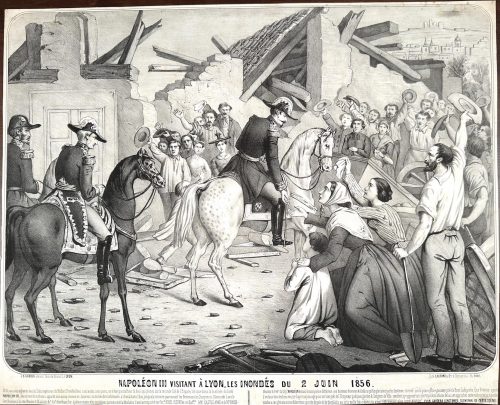 Lithography poster on wove paper, 492 x 614 mm; black ink stamp “5036” to reverse, vertical centerfold. Image in frame; under the frame left: "J. B. Gadola, éditeur. Cours de Brosses 1, à LYON."; right: "Lith LAURANT & Cie r. de Bernardins 34, Paris." Title and text below the image. Jean-Baptiste Gadola (French, 1818 – 1870) – publisher.
Lithography poster on wove paper, 492 x 614 mm; black ink stamp “5036” to reverse, vertical centerfold. Image in frame; under the frame left: "J. B. Gadola, éditeur. Cours de Brosses 1, à LYON."; right: "Lith LAURANT & Cie r. de Bernardins 34, Paris." Title and text below the image. Jean-Baptiste Gadola (French, 1818 – 1870) – publisher. -
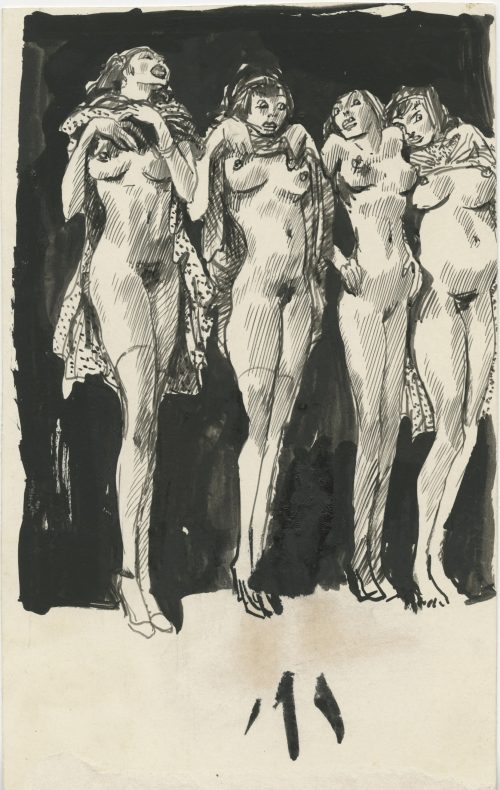 Drawing on both sides; Pen and wash, india ink, gouache, on cardboard, 225 x 140 mm, black ink stamp to verso: “Nachlaß O R SCHATS”, remnants of hinges. Attributed to Otto Rudolf Schatz (Austrian, 1900 – 1961).
Drawing on both sides; Pen and wash, india ink, gouache, on cardboard, 225 x 140 mm, black ink stamp to verso: “Nachlaß O R SCHATS”, remnants of hinges. Attributed to Otto Rudolf Schatz (Austrian, 1900 – 1961). -
 Iron tsuba of quatrefoil form with design of bamboo stems and leaves, and a plank bridge in openwork (sukashi). Hitsu-ana of irregular form. Iron with smooth chocolate patina. Copper and shakudō sekigane. This piece is illustrated in Sasano: Japanese Sword Guard Masterpieces from the Sasano Collection, 1994 on page 295 under № 254 with the following description:
Iron tsuba of quatrefoil form with design of bamboo stems and leaves, and a plank bridge in openwork (sukashi). Hitsu-ana of irregular form. Iron with smooth chocolate patina. Copper and shakudō sekigane. This piece is illustrated in Sasano: Japanese Sword Guard Masterpieces from the Sasano Collection, 1994 on page 295 under № 254 with the following description:Nishigaki. First generation Kanshiro (died in the sixth year of Genroku, 1693, at the age of 81). Sukashi design: Bamboo (take). Early Edo period, late 17th century (Kanbun / Enppo era). Height: 72.6 mm; Width: 71.5 mm; Rim thickness: .6 mm; Centre thickness: 5.1 mm. Rounded rim. The shape of this sword guard is a quatrefoil and the design is arranged in the form of a saddle flap. Two bamboo trunks with leaves comprise the design. Calm, soothing and sophisticated are the features of this artist in his later years. Such characteristics may remind one of the work of the first Hikozo.
Provenance: Sasano Masayuki collection, № 254. What is interesting, and what had been found by Bruce Kirkpatrick, is that in the earlier photograph of the same piece ['Sukashi tsuba - bushido no bi' by Sasano Masayuki, photography by Fujimoto Shihara, 1972 (in Japanese), page 245, №201] we clearly see kebori - linear carving that decorates the bamboo leaves and the planks of the bridge. The said kebori have totally disappeared between 1972 and 1994. The tsuba became absolutely flat! Now we can only speculate about the reasons for such cruel treatment of the artistically and historically important item.
Sukashi tsuba - bushido no bi. Author: Sasano Masayuki, photography: Fujimoto Shihara, 1972 (in Japanese). Page 245, №201.
-
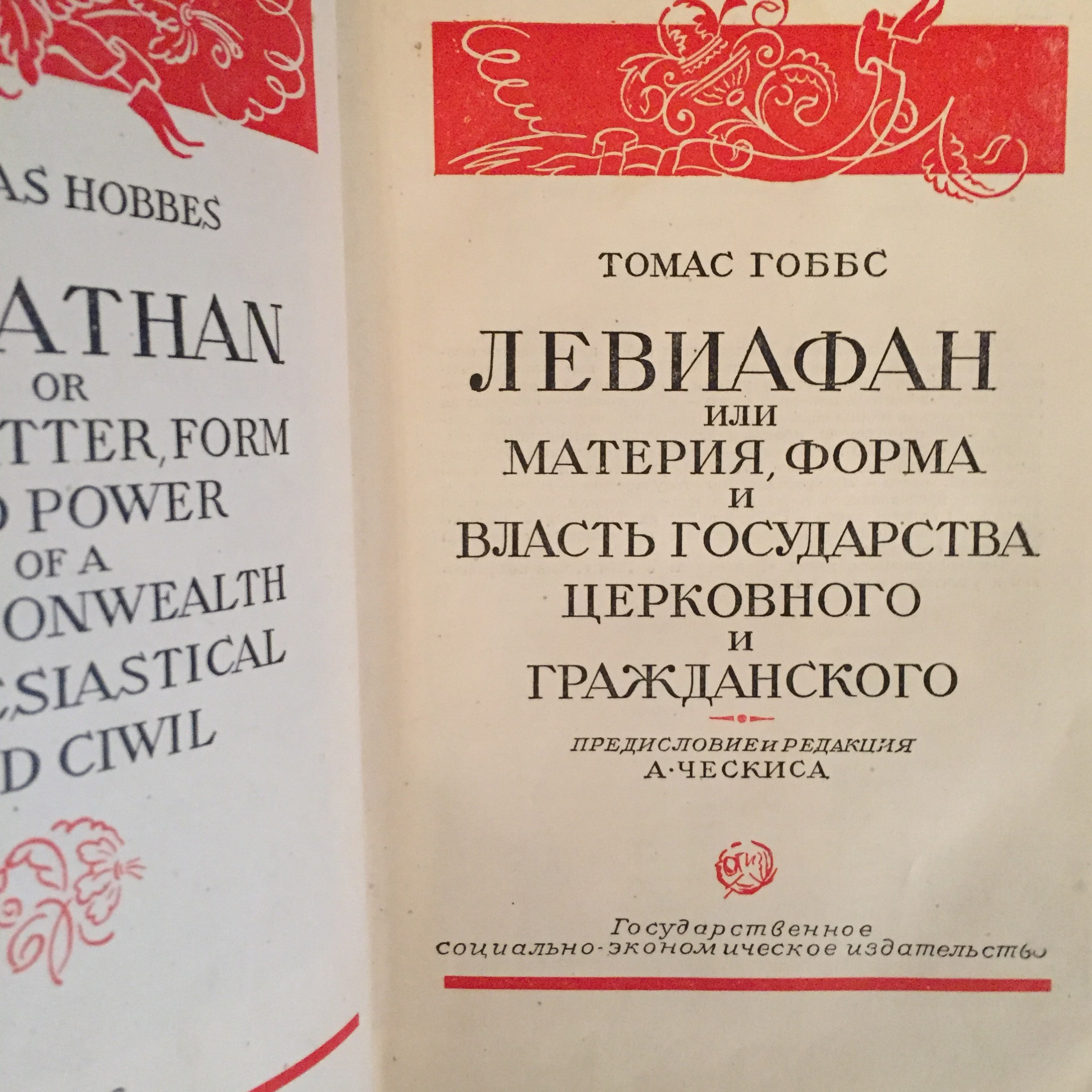
Гоббс Томас. Левиафан или материя, форма и власть государства церковного и гражданского. Предисловие и редакция А. Ческиса. - М.-Л.: Гос.соц.-эконом.из-во (СОЦЭКГИЗ), 1936. - 504 стр.
Тираж 10 000 экз.
Библиотека материализма. Томас Гоббс (1588-1679)ю
-
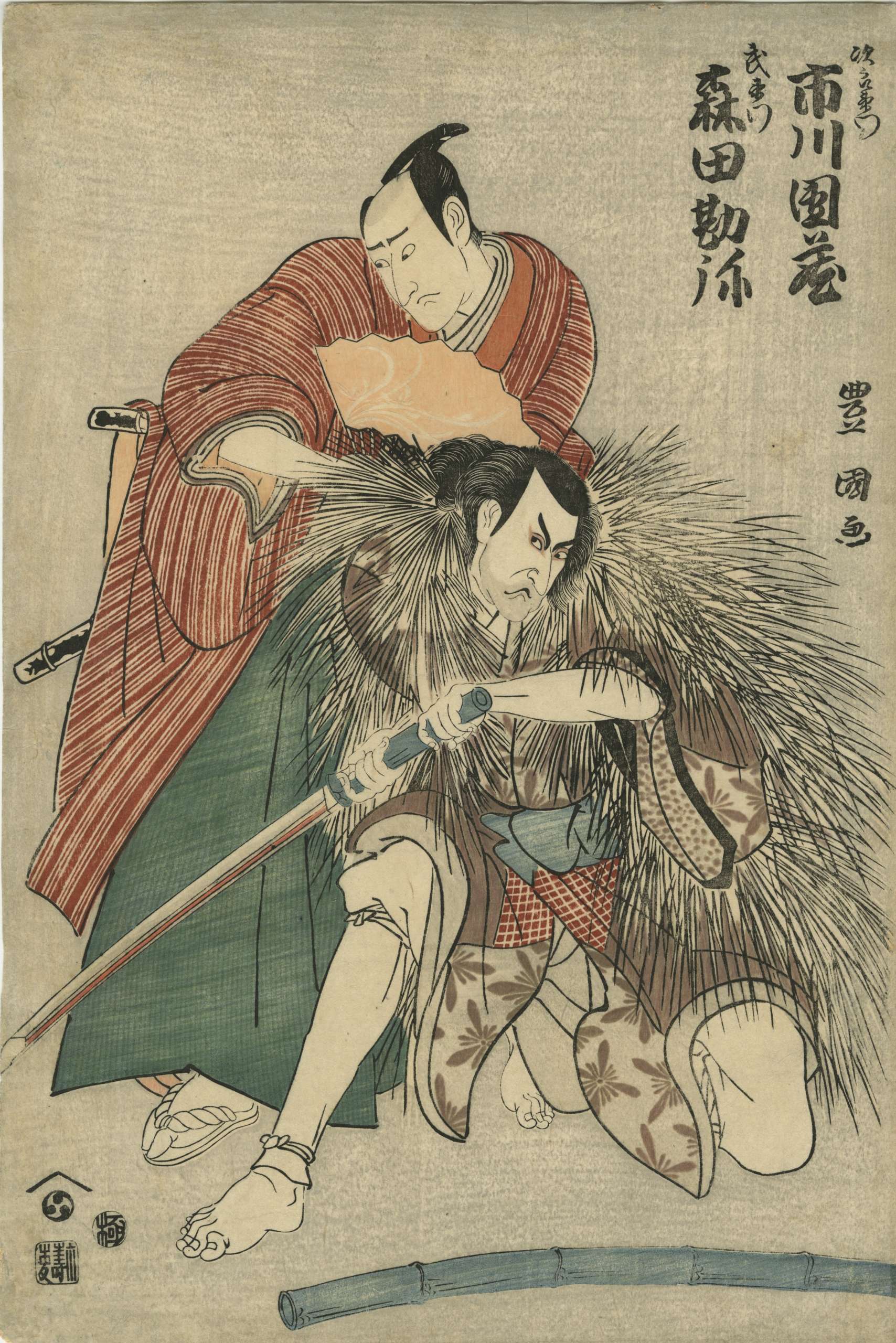 Utagawa Toyokuni (歌川豐國); 1769 – 24 February 1825. The kabuki actors Ichikawa Danzo IV as Jiroemon (in draw cape) and Morita Kanya VIII as Buemon. Play 'Oriai Tsuzure no Nishiki', performed at the Moritaza Theater in the 7th month of 1798. Publisher: Eijudo.
Utagawa Toyokuni (歌川豐國); 1769 – 24 February 1825. The kabuki actors Ichikawa Danzo IV as Jiroemon (in draw cape) and Morita Kanya VIII as Buemon. Play 'Oriai Tsuzure no Nishiki', performed at the Moritaza Theater in the 7th month of 1798. Publisher: Eijudo. -
 Iron tsuba of round form decorated with two boar's eyes (inome) and two dragonflies (tombo) in small openwork (ko-sukashi) outlined with brass wire. The plate also decorated with 2 to 5 concentric circular rows of brass dots (nail heads) in ten-zōgan. Center of the plate outlined with the inlaid circular brass wire. The inlaid metal is of red-ish hue, so it may be copper, and not brass. The surface has remnants of lacquer. Ōnin school. Mid Muromachi period, middle of 15th century. Dimensions: Diameter: 90 mm, thickness: 3.2 mm. Notes regarding design: "According to various sources, the dragonfly (tombo) is emblematic of martial success, as various names for the insect are homophones for words meaning "victory". The dragonfly is also auspicious because references in the Kojiki and Nihongi link it in both name and shape to the old kingdom of Yamato." [Merrily Baird. Symbols of Japan. Thematic motifs in art and design. Rizzoli international publications, Inc., 2001, p. 108]. "The dragonfly (tonbo), was also called kachimushi in earlier times, and due to the auspicious literal meaning "victory bug" of the characters of this word it became a popular theme on sword fittings." [Iron tsuba. The works of the exhibition "Kurogane no hana", The Japanese Sword Museum, 2014, p. 13]. Two other cutouts - in the form of what in European tradition symbolizes the heart, on the top and in the bottom of tsuba disc - may have two different explanations. The most usual one, inome - "Heart-shaped pattern, which is said to go back to the shape of a wild boar's eye" [Markus Sesko. Encyclopedia of Japanese Swords. Print and publishing: Lulu Enterprises, Inc., 2014.]. This understanding is shared by Robert Haynes [Robert E. Haynes. Study Collection of Japanese Sword Fittings. Nihon Art Publishers, 2010.] and elsewhere, with an exception of Okabe-Kakuya [Okabe-Kakuya. JAPANESE SWORD GUARDS. Museum of Fine Arts, Boston. In cooperation with the department of Chinese and Japanese art; - 1908, p. 14], who provides the illustration of inome-shaped cut-outs with the following explanation: " The tsuba shown in Fig. 13 approaches a square form with rounded corners and is perforated with Aoi decoration. But this book was written long time ago, when people even at MFA might not know enough...
Iron tsuba of round form decorated with two boar's eyes (inome) and two dragonflies (tombo) in small openwork (ko-sukashi) outlined with brass wire. The plate also decorated with 2 to 5 concentric circular rows of brass dots (nail heads) in ten-zōgan. Center of the plate outlined with the inlaid circular brass wire. The inlaid metal is of red-ish hue, so it may be copper, and not brass. The surface has remnants of lacquer. Ōnin school. Mid Muromachi period, middle of 15th century. Dimensions: Diameter: 90 mm, thickness: 3.2 mm. Notes regarding design: "According to various sources, the dragonfly (tombo) is emblematic of martial success, as various names for the insect are homophones for words meaning "victory". The dragonfly is also auspicious because references in the Kojiki and Nihongi link it in both name and shape to the old kingdom of Yamato." [Merrily Baird. Symbols of Japan. Thematic motifs in art and design. Rizzoli international publications, Inc., 2001, p. 108]. "The dragonfly (tonbo), was also called kachimushi in earlier times, and due to the auspicious literal meaning "victory bug" of the characters of this word it became a popular theme on sword fittings." [Iron tsuba. The works of the exhibition "Kurogane no hana", The Japanese Sword Museum, 2014, p. 13]. Two other cutouts - in the form of what in European tradition symbolizes the heart, on the top and in the bottom of tsuba disc - may have two different explanations. The most usual one, inome - "Heart-shaped pattern, which is said to go back to the shape of a wild boar's eye" [Markus Sesko. Encyclopedia of Japanese Swords. Print and publishing: Lulu Enterprises, Inc., 2014.]. This understanding is shared by Robert Haynes [Robert E. Haynes. Study Collection of Japanese Sword Fittings. Nihon Art Publishers, 2010.] and elsewhere, with an exception of Okabe-Kakuya [Okabe-Kakuya. JAPANESE SWORD GUARDS. Museum of Fine Arts, Boston. In cooperation with the department of Chinese and Japanese art; - 1908, p. 14], who provides the illustration of inome-shaped cut-outs with the following explanation: " The tsuba shown in Fig. 13 approaches a square form with rounded corners and is perforated with Aoi decoration. But this book was written long time ago, when people even at MFA might not know enough... The same interpretation of the said heart-like symbol (aoi leaf) is given at Helen C. Gunsaulus. Japanese sword-mounts in the collection of Field Museum. // Publication 216, Anthropological Series, Volume XVI; Chicago, 1923; p. 54: "This mokkō-formed tsuba recalls the aoi form, perforated as it is with the four aoi leaves." It is possible that the "wild boar's eye" theory was developed by later scholars.
The same interpretation of the said heart-like symbol (aoi leaf) is given at Helen C. Gunsaulus. Japanese sword-mounts in the collection of Field Museum. // Publication 216, Anthropological Series, Volume XVI; Chicago, 1923; p. 54: "This mokkō-formed tsuba recalls the aoi form, perforated as it is with the four aoi leaves." It is possible that the "wild boar's eye" theory was developed by later scholars.
 There is also a theory, supported by Graham Gemmell, saying that: “In simple terms Onin works are decorated Ko-Katchushi tsuba. … But, not content with iron alone, they began to decorate it with what was, in the early Muromachi period, a rare and valuable metal, brass. The Onin workers cut the design into the iron, using narrow channels, cast the brass, piece by piece, and then hammered it into the iron plate as though they were putting together a jigsaw. When complete the tsuba would be black lacquered exactly as the plain iron ones had been, the brass shining dully through it in a way that fulfilled the goal of shibui or restrained elegance.” [Tosogu. Treasure of the samurai. Fine Japanese Sword Fittings from The Muromachi to The Meiji Period, by Graham Gemmell. // Sarzi-Amadè Limited, London, 1991. An exhibition held in London from 21st March to 4th April, 1991]. The following illustration from Helen C. Gunsaulus. Japanese sword-mounts in the collection of Field Museum. // Publication 216, Anthropological Series, Volume XVI; Chicago, 1923; pp. 43 supports the idea.
There is also a theory, supported by Graham Gemmell, saying that: “In simple terms Onin works are decorated Ko-Katchushi tsuba. … But, not content with iron alone, they began to decorate it with what was, in the early Muromachi period, a rare and valuable metal, brass. The Onin workers cut the design into the iron, using narrow channels, cast the brass, piece by piece, and then hammered it into the iron plate as though they were putting together a jigsaw. When complete the tsuba would be black lacquered exactly as the plain iron ones had been, the brass shining dully through it in a way that fulfilled the goal of shibui or restrained elegance.” [Tosogu. Treasure of the samurai. Fine Japanese Sword Fittings from The Muromachi to The Meiji Period, by Graham Gemmell. // Sarzi-Amadè Limited, London, 1991. An exhibition held in London from 21st March to 4th April, 1991]. The following illustration from Helen C. Gunsaulus. Japanese sword-mounts in the collection of Field Museum. // Publication 216, Anthropological Series, Volume XVI; Chicago, 1923; pp. 43 supports the idea.
 Helen C. Gunsaulus' description of the dragonfly emblem is as follows: "This motive, the dragon-fly (akitsu), is generally accepted as a symbol of the kingdom of Japan, and the origin of the idea is traced to the legend recounted in the Kojiki and Nihongo of the Emperor Jimmu's view of the island from mountain top. He is said to have thought the kingdom looked like a dragon-fly touching its tail with its mouth. From this it received its name Akitsu-shima... etc."
Helen C. Gunsaulus' description of the dragonfly emblem is as follows: "This motive, the dragon-fly (akitsu), is generally accepted as a symbol of the kingdom of Japan, and the origin of the idea is traced to the legend recounted in the Kojiki and Nihongo of the Emperor Jimmu's view of the island from mountain top. He is said to have thought the kingdom looked like a dragon-fly touching its tail with its mouth. From this it received its name Akitsu-shima... etc."
-
 Shimizu-Jingo tsuba with a dragon and vajra (on reverse) motif. Unsigned. Possibly, 3rd or 4th master of Shimizu-Jingo family in Higo province. Iron. Low relief carving. Edo period, 1700's. Height: 75.4 mm, Width: 72.2 mm, Thickness at seppa-dai: 4.0 mm
Shimizu-Jingo tsuba with a dragon and vajra (on reverse) motif. Unsigned. Possibly, 3rd or 4th master of Shimizu-Jingo family in Higo province. Iron. Low relief carving. Edo period, 1700's. Height: 75.4 mm, Width: 72.2 mm, Thickness at seppa-dai: 4.0 mm -
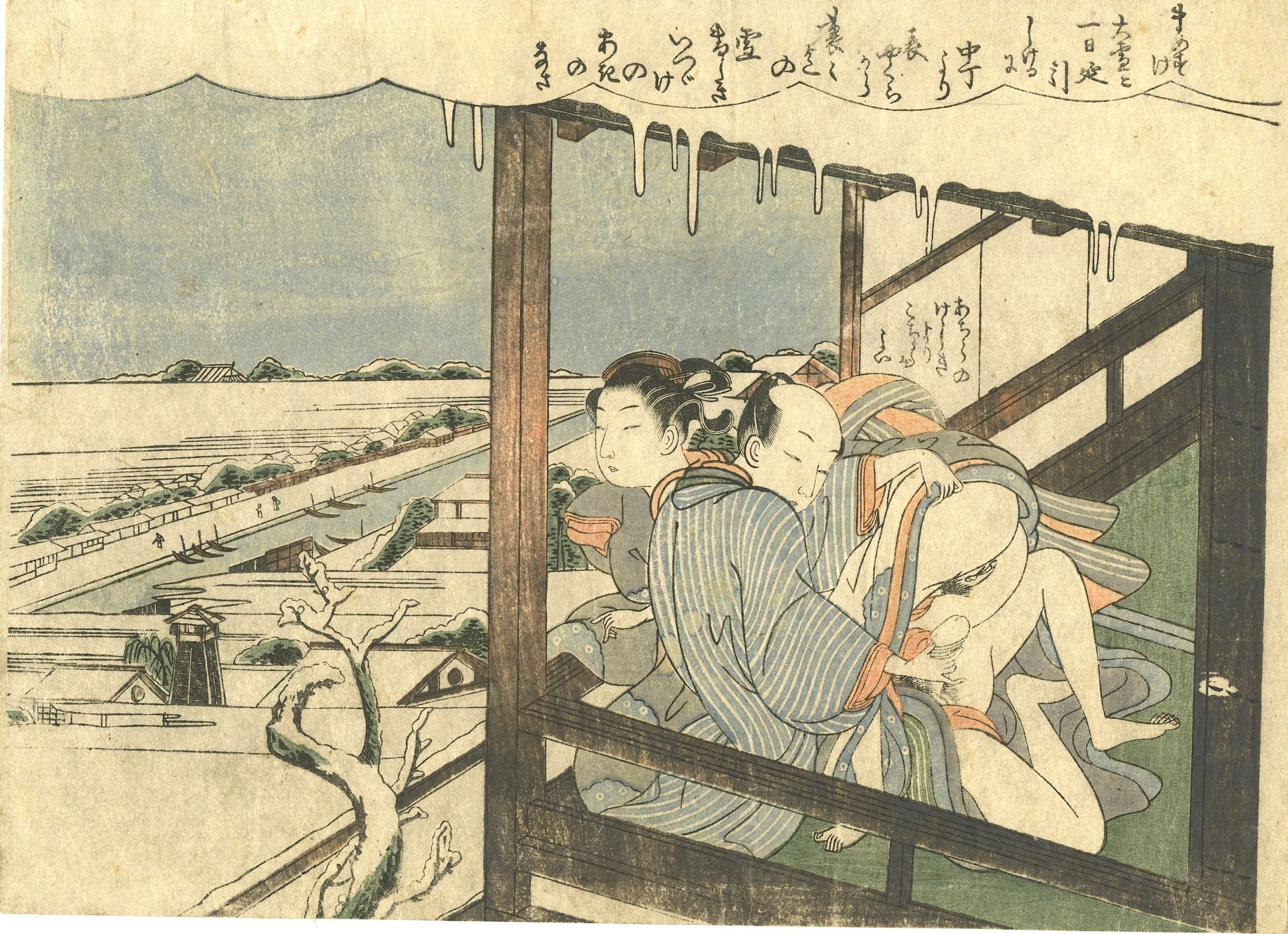 Unsigned print, attributed to Suzuki Harunobu. Erotic scene on open veranda with a winter landscape on background.
Unsigned print, attributed to Suzuki Harunobu. Erotic scene on open veranda with a winter landscape on background. -
 The Seven Gods of Good Luck in the Takarabune (ship of fortune) with a crane (the phoenix) above them.
The Seven Gods of Good Luck in the Takarabune (ship of fortune) with a crane (the phoenix) above them.Attributed to Katsukawa Shunshō, fl. 1726–92. Publisher: Uemura from Shiba (Edo). Marks "Publishers": U361|25-300: Uemura han (1793-1813). Marks "Artists, publishers...": Emiya Kichiemon (1688-1835). Artist signature absent. Looks very much like Pins #565 [p.223], but NOT the same. This exact design has not been found anywhere.

-

Iron tsuba of mokkō form decorated with inome (wild boar's eye) in openwork (sukashi) outlined with brass wire. The plate decorated with 3 concentric circular rows of brass dots in ten-zōgan. Center of the plate outlined with the inlaid circular brass wire (sen-zōgan). Some dots and the outline of inome on the face are missing.
Ōnin school. Unsigned. Mid Muromachi period, middle of the 15th century. Dimensions: 72.1 x 71.3 x 2.3 mm. -
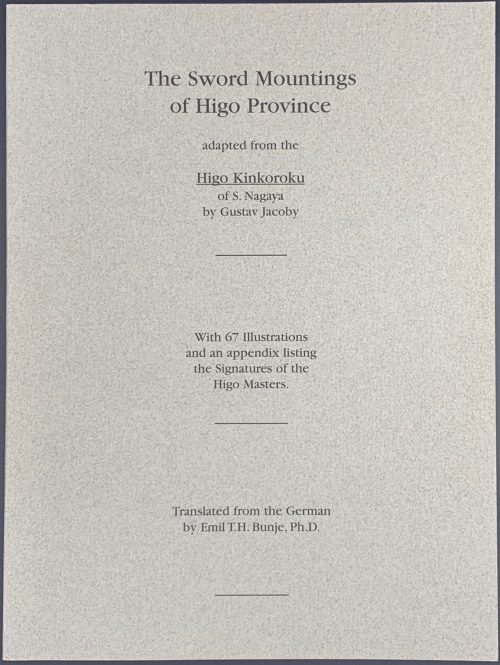
The sword mountings of Higo Province adapted from the Higo Kinkoroku of S. Nagaya by Gustav Jacoby, with 67 illustrations and an appendix listing the signatures of the Higo masters. Translated from the German by Emil T. H. Bunje, PhD.
Book size: 24.5 x 18.4 cm/
Softbound, original grey paper wrappers with black lettering.
Higo Kinkoroku, or Register of Metalworkers of Higo Province, published in 1902 in Tokyo by the Japanese Colonel Nagaya Shigena with a preface by viscount Nagaoka Moriyoshi, scion of the Hoshikawa family, Daimyo of Kumamoto in Higo Province.
Translated from the orignial: Die schwertzieraten der provinz Higo. Bearbeitet nach dem japanischen werke Higo Kinkoroku des S. Nagaya, von Gustav Jacoby. Mit 67 Abbildungen und einem Anhang: Die bezeichnungen der Higo-meister. 5. beiheft zum Jahrbuch der hamburgischen wissenschaftlichen anstalten. XXII. 1904. Hamburg, Lucas Gräfe & Sillem, 1905. - 62 p. illus., pl. [LIB-1947.2019] -
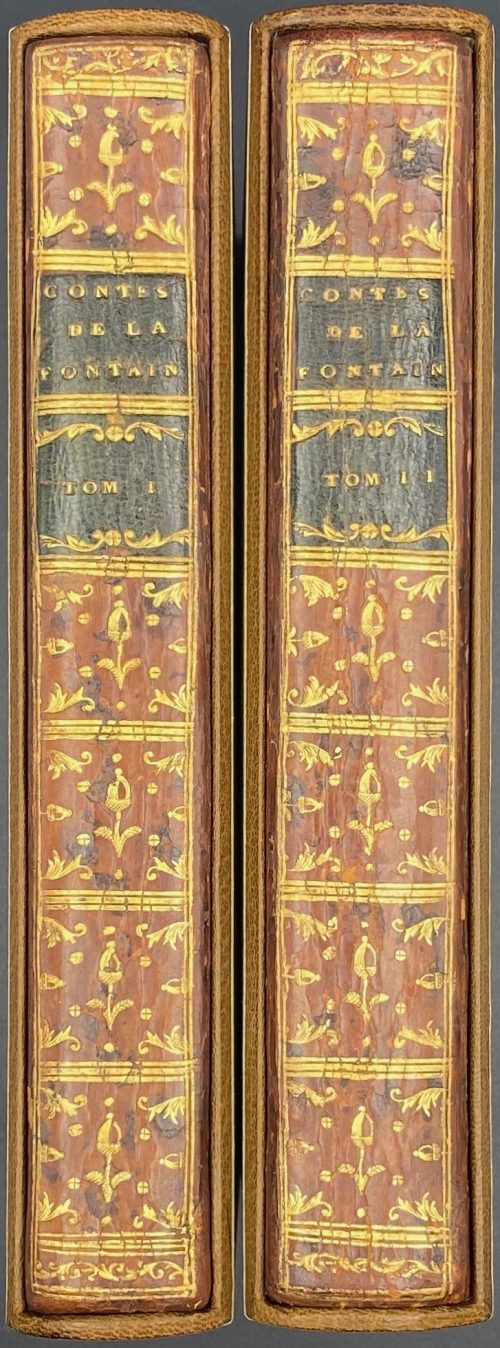 Two-volume edition, financed, arranged and managed by Fermiers généraux. Vol. 1. Title : CONTES | ET | NOUVELLES | EN VERS, | Par M. de La Fontaine. | TOME I. | {vignette} | A AMSTERDAM. | — | M. DCC. LXII. || Pagination: [2] – blanks [i, ii] – h.t. / blank, [iii, iv] – t.p. / blank, v-xiv, [1] 2–268 [269-70] – table, [4] – blanks, plus frontispiece by Fiquet after Rigault, t.p. vignette, vignette, headpiece, and 23 tailpieces by Choffard, 39 plates by various engravers after Charles Eisen. Vol. 2. Title: same but TOME II. Pagination: [2] – blanks] [i, ii] – h.t. / blank, [iii] iv-viii [1] 2–306 [307-10] – épitaphe / table, [4] – blanks, plus frontispiece by Fiquet after Vispré, t.p. vignette, vignette, headpiece, and 29 tailpieces by Choffard, and 42 plates after Charles Eisen (Ray only cite 41 plates). Binding: 2 volumes, 19.8 x 12.2 each, uniformly bound in full Spanish mottled calf, boards triple ruled in gilt, flat spine with triple bands, double ruled and tooled in gilt, black title labels lettered in gilt, all margins gilt, marbled end-papers, in cardboard slipcases, openings leathered. In vol. 1 a manuscript plate 4.8 x 8.2 cm pasted to page [1]: "Cette Édition est très rare n’y ayant | eu que 30 Exemplaires de livres, ou la figure principale dans le Cas de Conscience page 143 Tom 2 est nud tandis que dans les autres Éditions cette Figure est voilée par un feuillage".
Two-volume edition, financed, arranged and managed by Fermiers généraux. Vol. 1. Title : CONTES | ET | NOUVELLES | EN VERS, | Par M. de La Fontaine. | TOME I. | {vignette} | A AMSTERDAM. | — | M. DCC. LXII. || Pagination: [2] – blanks [i, ii] – h.t. / blank, [iii, iv] – t.p. / blank, v-xiv, [1] 2–268 [269-70] – table, [4] – blanks, plus frontispiece by Fiquet after Rigault, t.p. vignette, vignette, headpiece, and 23 tailpieces by Choffard, 39 plates by various engravers after Charles Eisen. Vol. 2. Title: same but TOME II. Pagination: [2] – blanks] [i, ii] – h.t. / blank, [iii] iv-viii [1] 2–306 [307-10] – épitaphe / table, [4] – blanks, plus frontispiece by Fiquet after Vispré, t.p. vignette, vignette, headpiece, and 29 tailpieces by Choffard, and 42 plates after Charles Eisen (Ray only cite 41 plates). Binding: 2 volumes, 19.8 x 12.2 each, uniformly bound in full Spanish mottled calf, boards triple ruled in gilt, flat spine with triple bands, double ruled and tooled in gilt, black title labels lettered in gilt, all margins gilt, marbled end-papers, in cardboard slipcases, openings leathered. In vol. 1 a manuscript plate 4.8 x 8.2 cm pasted to page [1]: "Cette Édition est très rare n’y ayant | eu que 30 Exemplaires de livres, ou la figure principale dans le Cas de Conscience page 143 Tom 2 est nud tandis que dans les autres Éditions cette Figure est voilée par un feuillage".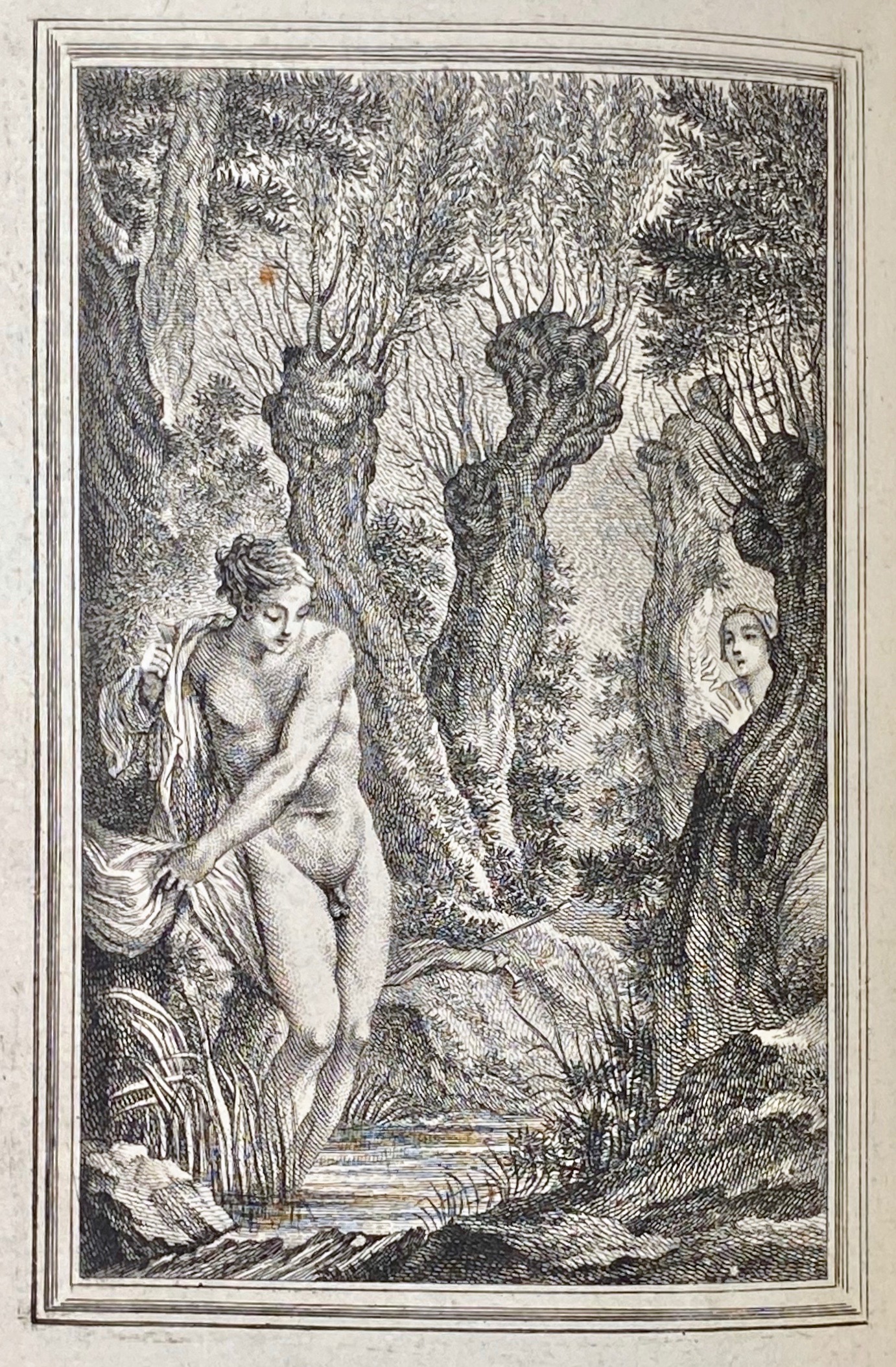
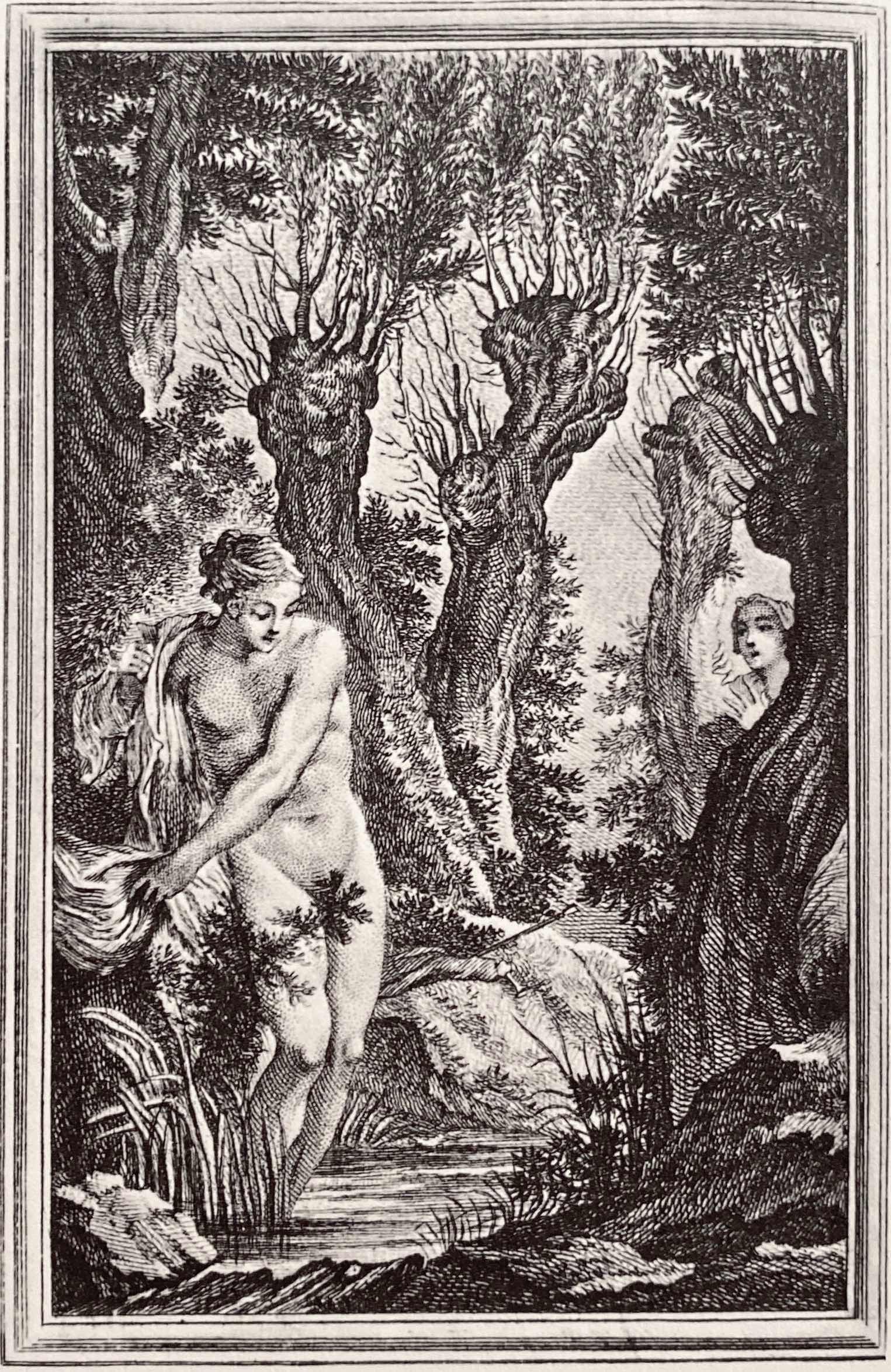 Contributors:
Jean de La Fontaine (French, 1621–1695) – author.
Fermiers généraux and Jean Baptiste Séroux d'Agincourt (French, 1730 – 1814) – publisher.
Joseph Gérard Barbou (French, 1723–1790) – printer.
Artists:
Charles Eisen (French, 1720 – 1778)
François Xavier Vispré (British-French, c.1730 – 1789 or after)
Hyacinthe Rigaud [Jacint Rigau-Ros i Serra] (Catalan-French, 1659 – 1743)
Engravers:
Joseph de Longueil (French, 1730 – 1792)
Noël Le Mire (French, 1724 – 1801)
Jean-Jacques André Le Veau (French, 1729 – 1786)
Jacques Aliamet (French, 1726 – 1788)
Jean Charles Baquoy (French, 1721 – 1777)
Pierre-Philippe Choffard (French, 1730 – 1809)
Jean Jacques Flipart (French, 1719 – 1782)
Louis Simon Lempereur (French, 1725 – 1796)
Jean Ouvrier (French, 1725 – 1784)
Contributors:
Jean de La Fontaine (French, 1621–1695) – author.
Fermiers généraux and Jean Baptiste Séroux d'Agincourt (French, 1730 – 1814) – publisher.
Joseph Gérard Barbou (French, 1723–1790) – printer.
Artists:
Charles Eisen (French, 1720 – 1778)
François Xavier Vispré (British-French, c.1730 – 1789 or after)
Hyacinthe Rigaud [Jacint Rigau-Ros i Serra] (Catalan-French, 1659 – 1743)
Engravers:
Joseph de Longueil (French, 1730 – 1792)
Noël Le Mire (French, 1724 – 1801)
Jean-Jacques André Le Veau (French, 1729 – 1786)
Jacques Aliamet (French, 1726 – 1788)
Jean Charles Baquoy (French, 1721 – 1777)
Pierre-Philippe Choffard (French, 1730 – 1809)
Jean Jacques Flipart (French, 1719 – 1782)
Louis Simon Lempereur (French, 1725 – 1796)
Jean Ouvrier (French, 1725 – 1784)
Étienne Ficquet (French 1719 – 1794)
Catalogue raisonné: Ray (French): №26, pp. 54-56; Cohen-DeRicci: 558-571; Lewine: 278-280. -
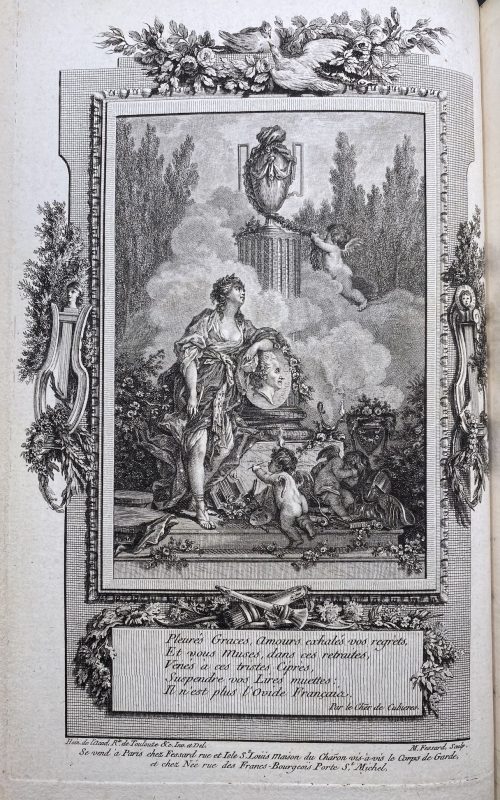 Title page: LES | BAISERS , | PRÉCÉDES | DU MOIS DE MAI, | POËME. | [vignette] | A LA HAYE , | Et se trouve à Paris | Chez Lambert , Imprimeur, rue de la Harpe. | Et Delalain , rue de la Comédie Françoise. | M. DCC. LXX Size: 8vo; 24.5 x 15.5 cm; Binding by Hippolyte Duru – stamp at the back of the front end paper DURU, 1855; full red calf, boards decorated in gilt, raised bands and gilt decorations in compartments, gilt lettering, AEG, peacock marbled end papers, text and illustrations printed on Holland paper. Collation: 2 ffls, engraved half-title by N. Ponce after Ch. Eisen, frontispiece by Etienne Fessard after Claude-Jean-Baptiste Hoin (French, 1750 – 1817) w/guard tissue, t.p. by J. Aliamet after Ch. Eisen, Réflexions préliminaires: A8, B4; 'Le Mois de Mai' half-title, imprim. note on verso, frontispice by De Longueil after Ch. Eisen w/guard tissue, A4 C-F(8) H4; 2bfls. Frontispiece by Etienne Fessard is unique in this edition. Pagination: [2] 3-24, [27]/28, 5/6, 31/32 31/34 11/12 37-119 [120], 22 head-pieces after Ch. Eisen and 22 end-pieces after Marillier, engraved by Baquoy, Binet, Delaunay, Lingée, De Longueil, Masquelier, Massard, and Née. Mistakes in pagination likely confirms first printing first edition. Catalogue raisonné: Cohen, De Ricci (1912): 308-311). Artists: Charles Eisen (French, 1720–1778); Clément Pierre Marillier (French, 1740–1808), and Claude-Jean-Baptiste Hoin (French, 1750–1817). Engravers: Jacques Aliamet (French, 1726–1788); Jean Charles Baquoy (French, 1721–1777); Louis Binet (French, 1744–about 1800); Nicolas Delaunay (French, 1739–1792); Etienne Fessard (French, 1714–1777); Charles Louis Lingée (French, 1748–1819); Joseph de Longueil (French, 1730–1792); Louis Joseph Masquelier (French, 1741–1811); Jean Massard (1740–1822); François Denis Née (French, 1735–1818); Nicholas Ponce (French, 1746–1831).
Title page: LES | BAISERS , | PRÉCÉDES | DU MOIS DE MAI, | POËME. | [vignette] | A LA HAYE , | Et se trouve à Paris | Chez Lambert , Imprimeur, rue de la Harpe. | Et Delalain , rue de la Comédie Françoise. | M. DCC. LXX Size: 8vo; 24.5 x 15.5 cm; Binding by Hippolyte Duru – stamp at the back of the front end paper DURU, 1855; full red calf, boards decorated in gilt, raised bands and gilt decorations in compartments, gilt lettering, AEG, peacock marbled end papers, text and illustrations printed on Holland paper. Collation: 2 ffls, engraved half-title by N. Ponce after Ch. Eisen, frontispiece by Etienne Fessard after Claude-Jean-Baptiste Hoin (French, 1750 – 1817) w/guard tissue, t.p. by J. Aliamet after Ch. Eisen, Réflexions préliminaires: A8, B4; 'Le Mois de Mai' half-title, imprim. note on verso, frontispice by De Longueil after Ch. Eisen w/guard tissue, A4 C-F(8) H4; 2bfls. Frontispiece by Etienne Fessard is unique in this edition. Pagination: [2] 3-24, [27]/28, 5/6, 31/32 31/34 11/12 37-119 [120], 22 head-pieces after Ch. Eisen and 22 end-pieces after Marillier, engraved by Baquoy, Binet, Delaunay, Lingée, De Longueil, Masquelier, Massard, and Née. Mistakes in pagination likely confirms first printing first edition. Catalogue raisonné: Cohen, De Ricci (1912): 308-311). Artists: Charles Eisen (French, 1720–1778); Clément Pierre Marillier (French, 1740–1808), and Claude-Jean-Baptiste Hoin (French, 1750–1817). Engravers: Jacques Aliamet (French, 1726–1788); Jean Charles Baquoy (French, 1721–1777); Louis Binet (French, 1744–about 1800); Nicolas Delaunay (French, 1739–1792); Etienne Fessard (French, 1714–1777); Charles Louis Lingée (French, 1748–1819); Joseph de Longueil (French, 1730–1792); Louis Joseph Masquelier (French, 1741–1811); Jean Massard (1740–1822); François Denis Née (French, 1735–1818); Nicholas Ponce (French, 1746–1831). -
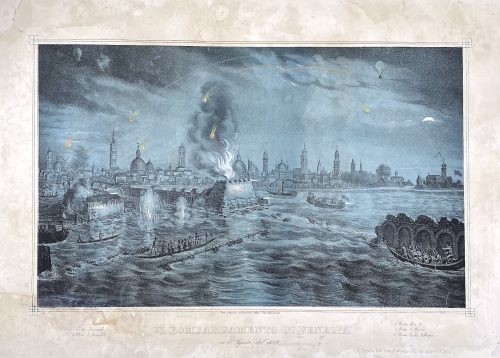 Quaritch's description: Single sheet (435 x 625 mm); coloured lithograph by Kirchmayr after a drawing by M. Fontana; hand-painted details; signed to lower left ‘M. Fon[tana]’ and to lower right ‘M. Fontana Edit. Prop. S. Giacomo dall’Orio in Isola N°.1481’; lower margin with the title ‘Il bombardamento di Venezia nell’Agosto 1849’ and key; restored tears in many places, especially along upper and lower blank margins, some affecting print; losses to lower left corner, affecting a small portion of the print, ruled border, and key, restored and re-drawn where needed; loss to the upper left corner of blank margin; two small areas of restoration to the centre of upper blank margin; the whole sheet backed; nevertheless a remarkable survival. Exceedingly rare and striking lithograph of Venice as seen from Fusina, depicting the first ever aerial bombardment in history. The bombardment took place in 1849, under the orders of Field Marshal Josef Radetzky (1766–1858), to quell the revolts that had started the previous year during the First Italian War of Independence. This curious and little-known action was the brainchild of Colonel Benno Uchatius, a brilliant young officer in the Austro-Hungarian Artillery. After long months of unsuccessful siege, Uchatius decided to deploy an unusual weapon: a hot air balloon able to bomb the city from above. Having calculated the wind speed and direction and evaluated the requisite dimensions of the hot-air balloon, Uchatius set up a workshop near Mestre, where a group of engineers and craftsmen began to manufacture a balloon equipped with a large wicker basket which could transport two crewmen and approximately one hundred kilograms of small long-fuse devices (metal spheres filled with gunpowder, pitch, oil and five hundred rifle buckshot). The initial trials, however, proved to be a disaster, because the balloon would drift off course, making it impossible to accurately deploy the bombs. Uchatius then hit upon the idea of using several smaller unmanned balloons roped together. These were to be launched over the city and, using the position of the first ‘pilot’ balloon, which was unarmed, the Austrians could calculate the correct fuse settings for the bombs. The ‘bomber’ balloons had a cloth envelope of one hundred cubic metres and a reduced load of about twenty kilograms of ordnance. According to Uchatius’ calculations, the line of balloons, launched from Mestre, would reach the lagoon city in thirty-five to forty minutes, carried by the north-west wind. In July 1849, a first launch was attempted, but when a breeze began to blow from the sea some of the balloons broke the connecting ropes and floated away, while others settled in the water in front of the northern part of the city, where a curious crowd of Venetians observed the failure of the enterprise and commented colourfully on the ‘buffoonery of Radetzky’. Uchatius’ second attempt, which is depicted in this lithograph, was also largely unsuccessful: only a few of the unmanned bomber balloons reached their target, and some even drifted back over the Austrian lines. Uchatius, having accomplished the first ever aerial bombardment, and having designed the first ever military ‘drones’, was forced to abandon the project permanently. Another fascinating aspect of this work is the vantage point used to depict the city of Venice, seen here from Fusina, a very rare viewpoint that makes this piece even more remarkable. We were unable to locate any copies in any institution or bibliography. G. Kirchmayr (fl. mid-19th century) is mentioned at British Museum database as "Lithographer active in Venice; related to Venetian painter Cherubino Kirchmayr (b. 1848)?" However, I was not able to find that name on the print. Not much is known of M. Fontana either.
Quaritch's description: Single sheet (435 x 625 mm); coloured lithograph by Kirchmayr after a drawing by M. Fontana; hand-painted details; signed to lower left ‘M. Fon[tana]’ and to lower right ‘M. Fontana Edit. Prop. S. Giacomo dall’Orio in Isola N°.1481’; lower margin with the title ‘Il bombardamento di Venezia nell’Agosto 1849’ and key; restored tears in many places, especially along upper and lower blank margins, some affecting print; losses to lower left corner, affecting a small portion of the print, ruled border, and key, restored and re-drawn where needed; loss to the upper left corner of blank margin; two small areas of restoration to the centre of upper blank margin; the whole sheet backed; nevertheless a remarkable survival. Exceedingly rare and striking lithograph of Venice as seen from Fusina, depicting the first ever aerial bombardment in history. The bombardment took place in 1849, under the orders of Field Marshal Josef Radetzky (1766–1858), to quell the revolts that had started the previous year during the First Italian War of Independence. This curious and little-known action was the brainchild of Colonel Benno Uchatius, a brilliant young officer in the Austro-Hungarian Artillery. After long months of unsuccessful siege, Uchatius decided to deploy an unusual weapon: a hot air balloon able to bomb the city from above. Having calculated the wind speed and direction and evaluated the requisite dimensions of the hot-air balloon, Uchatius set up a workshop near Mestre, where a group of engineers and craftsmen began to manufacture a balloon equipped with a large wicker basket which could transport two crewmen and approximately one hundred kilograms of small long-fuse devices (metal spheres filled with gunpowder, pitch, oil and five hundred rifle buckshot). The initial trials, however, proved to be a disaster, because the balloon would drift off course, making it impossible to accurately deploy the bombs. Uchatius then hit upon the idea of using several smaller unmanned balloons roped together. These were to be launched over the city and, using the position of the first ‘pilot’ balloon, which was unarmed, the Austrians could calculate the correct fuse settings for the bombs. The ‘bomber’ balloons had a cloth envelope of one hundred cubic metres and a reduced load of about twenty kilograms of ordnance. According to Uchatius’ calculations, the line of balloons, launched from Mestre, would reach the lagoon city in thirty-five to forty minutes, carried by the north-west wind. In July 1849, a first launch was attempted, but when a breeze began to blow from the sea some of the balloons broke the connecting ropes and floated away, while others settled in the water in front of the northern part of the city, where a curious crowd of Venetians observed the failure of the enterprise and commented colourfully on the ‘buffoonery of Radetzky’. Uchatius’ second attempt, which is depicted in this lithograph, was also largely unsuccessful: only a few of the unmanned bomber balloons reached their target, and some even drifted back over the Austrian lines. Uchatius, having accomplished the first ever aerial bombardment, and having designed the first ever military ‘drones’, was forced to abandon the project permanently. Another fascinating aspect of this work is the vantage point used to depict the city of Venice, seen here from Fusina, a very rare viewpoint that makes this piece even more remarkable. We were unable to locate any copies in any institution or bibliography. G. Kirchmayr (fl. mid-19th century) is mentioned at British Museum database as "Lithographer active in Venice; related to Venetian painter Cherubino Kirchmayr (b. 1848)?" However, I was not able to find that name on the print. Not much is known of M. Fontana either. -
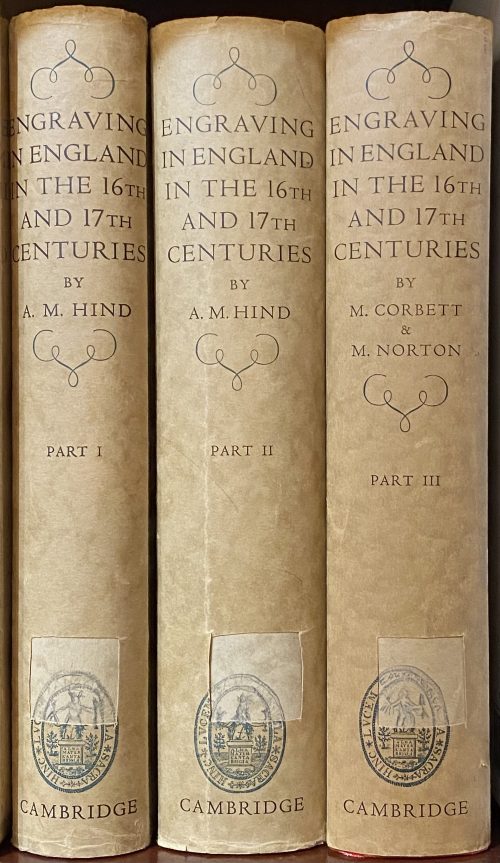 A three-volume set. VOL. 1: ENGRAVING IN ENGLAND | IN THE | SIXTEENTH AND SEVENTEENTH CENTURIES | A DESCRIPTIVE CATALOGUE | WITH INTRODUCTIONS | BY | ARTHUR M HIND | Sometime Keeper of Prints and Drawings in the British Museum | and Slade Professor of Fine Art in the University of Oxford | PART I | THE TUDOR PERIOD | WITH 319 ILLUSTRATIONS | {The coat of arms of the University of Cambridge} | CAMBRIDGE | AT THE UNIVERSITY PRESS | 1952|| Pagination: ffl, [i-vi] – h.t. / blank, frontis., t.p. / colophon, dedication / blank; vii-xxx; 1-333 [334 blank] [2] – the plates / blank; 1-156 pp. of plates. Collation: a-b8, 1-218 + 78 leaves of plates at the end. VOL. 2: ENGRAVING IN ENGLAND | IN THE | SIXTEENTH AND SEVENTEENTH CENTURIES | A DESCRIPTIVE CATALOGUE | WITH INTRODUCTIONS | BY | ARTHUR M HIND | Sometime Keeper of Prints and Drawings in the British Museum | and Slade Professor of Fine Art in the University of Oxford | PART II | THE REIGN OF JAMES I | WITH 618 ILLUSTRATIONS| {The coat of arms of the University of Cambridge} | CAMBRIDGE | AT THE UNIVERSITY PRESS | 1955|| Pagination: [i-iv] – h.t. / blank, t.p. / colophon; v-xiv [xv] [xvi blank]; 1-396 [397] [398 blank] [2] – the plates / blank; 1-252 pp. of plates. Collation: a-b8, 1-268 + 126 leaves of plates at the end. VOL. 3: ENGRAVING IN ENGLAND | IN THE | SIXTEENTH AND SEVENTEENTH CENTURIES | A DESCRIPTIVE CATALOGUE | WITH INTRODUCTIONS | PART III | THE REIGN OF CHARLES I | WITH 466 ILLUSTRATIONS | COMPILED FROM THE NOTES OF | THE LATE A. M. HIND | BY | MARGERY CORBETT & MICHAEL NORTON | {The coat of arms of the University of Cambridge} | CAMBRIDGE | AT THE UNIVERSITY PRESS | 1964|| Pagination: [i-vi] – h.t. / blank, frontis., t.p. / colophon, dedication / blank; vii-xxx; 1-333 [334 blank] [2] – the plates / blank; 1-214 pp. of plates. Collation: [a]8, 1-258 + 107 leaves of plates at the end. Each of three volumes bound in red cloth with gilt lettering to spine, residuals of library stickers, dark spotting to the top and lateral edges; tan DJ with title lettering in a frame to front, lettering to spine, advert. to back, with cut off stickers to spine; ‘The Francis Bacon Foundation’ ink stamp to front pastedown.
A three-volume set. VOL. 1: ENGRAVING IN ENGLAND | IN THE | SIXTEENTH AND SEVENTEENTH CENTURIES | A DESCRIPTIVE CATALOGUE | WITH INTRODUCTIONS | BY | ARTHUR M HIND | Sometime Keeper of Prints and Drawings in the British Museum | and Slade Professor of Fine Art in the University of Oxford | PART I | THE TUDOR PERIOD | WITH 319 ILLUSTRATIONS | {The coat of arms of the University of Cambridge} | CAMBRIDGE | AT THE UNIVERSITY PRESS | 1952|| Pagination: ffl, [i-vi] – h.t. / blank, frontis., t.p. / colophon, dedication / blank; vii-xxx; 1-333 [334 blank] [2] – the plates / blank; 1-156 pp. of plates. Collation: a-b8, 1-218 + 78 leaves of plates at the end. VOL. 2: ENGRAVING IN ENGLAND | IN THE | SIXTEENTH AND SEVENTEENTH CENTURIES | A DESCRIPTIVE CATALOGUE | WITH INTRODUCTIONS | BY | ARTHUR M HIND | Sometime Keeper of Prints and Drawings in the British Museum | and Slade Professor of Fine Art in the University of Oxford | PART II | THE REIGN OF JAMES I | WITH 618 ILLUSTRATIONS| {The coat of arms of the University of Cambridge} | CAMBRIDGE | AT THE UNIVERSITY PRESS | 1955|| Pagination: [i-iv] – h.t. / blank, t.p. / colophon; v-xiv [xv] [xvi blank]; 1-396 [397] [398 blank] [2] – the plates / blank; 1-252 pp. of plates. Collation: a-b8, 1-268 + 126 leaves of plates at the end. VOL. 3: ENGRAVING IN ENGLAND | IN THE | SIXTEENTH AND SEVENTEENTH CENTURIES | A DESCRIPTIVE CATALOGUE | WITH INTRODUCTIONS | PART III | THE REIGN OF CHARLES I | WITH 466 ILLUSTRATIONS | COMPILED FROM THE NOTES OF | THE LATE A. M. HIND | BY | MARGERY CORBETT & MICHAEL NORTON | {The coat of arms of the University of Cambridge} | CAMBRIDGE | AT THE UNIVERSITY PRESS | 1964|| Pagination: [i-vi] – h.t. / blank, frontis., t.p. / colophon, dedication / blank; vii-xxx; 1-333 [334 blank] [2] – the plates / blank; 1-214 pp. of plates. Collation: [a]8, 1-258 + 107 leaves of plates at the end. Each of three volumes bound in red cloth with gilt lettering to spine, residuals of library stickers, dark spotting to the top and lateral edges; tan DJ with title lettering in a frame to front, lettering to spine, advert. to back, with cut off stickers to spine; ‘The Francis Bacon Foundation’ ink stamp to front pastedown. -
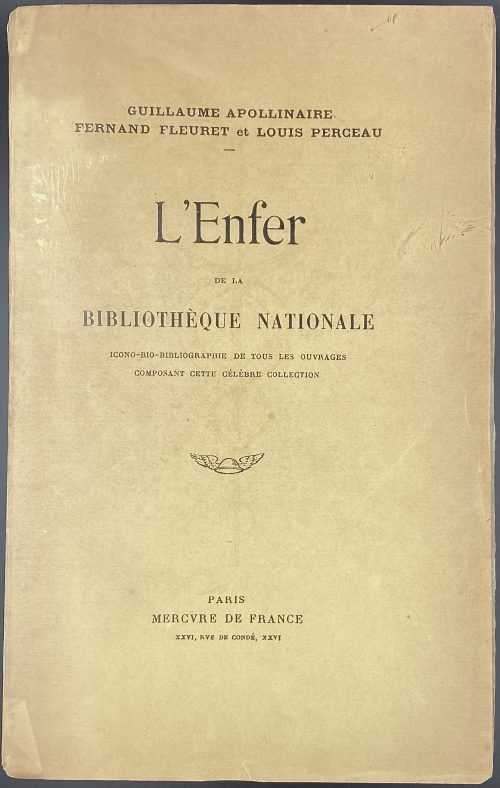 Title: GUILLAUME APOLLINAIRE | FERNAND FLEURET LOUIS PERCEAU | L'Enfer | DE LA | BIBLIOTHÈQUE NATIONALE | ICONO-BIO-BIBLIOGRAPHIE | DESCRIPTIVE, CRITIQUE ET RAISONNÉE, | COMPLÈTE A CE JOUR | DE TOUS LES OUVRAGES COMPOSANT CETTE CÉLÈBRE COLLECTION | AVEC UN INDEX ALPHABÉTIQUE | DES TITRES ET NOMS D'AUTEURS | PARIS | MERCVRE DE FRANCE | XXVI, RVE DE CONDÉ, XXVI | MCMXII || Pagination: ffl, [1-5] 6-415 [416], bfl. Collation: [1]8 2-268. Binding: Original tan wrappers, lettering to covers and spine. Edition: First edition of which this is №952. Ref.: BnF
Title: GUILLAUME APOLLINAIRE | FERNAND FLEURET LOUIS PERCEAU | L'Enfer | DE LA | BIBLIOTHÈQUE NATIONALE | ICONO-BIO-BIBLIOGRAPHIE | DESCRIPTIVE, CRITIQUE ET RAISONNÉE, | COMPLÈTE A CE JOUR | DE TOUS LES OUVRAGES COMPOSANT CETTE CÉLÈBRE COLLECTION | AVEC UN INDEX ALPHABÉTIQUE | DES TITRES ET NOMS D'AUTEURS | PARIS | MERCVRE DE FRANCE | XXVI, RVE DE CONDÉ, XXVI | MCMXII || Pagination: ffl, [1-5] 6-415 [416], bfl. Collation: [1]8 2-268. Binding: Original tan wrappers, lettering to covers and spine. Edition: First edition of which this is №952. Ref.: BnF -
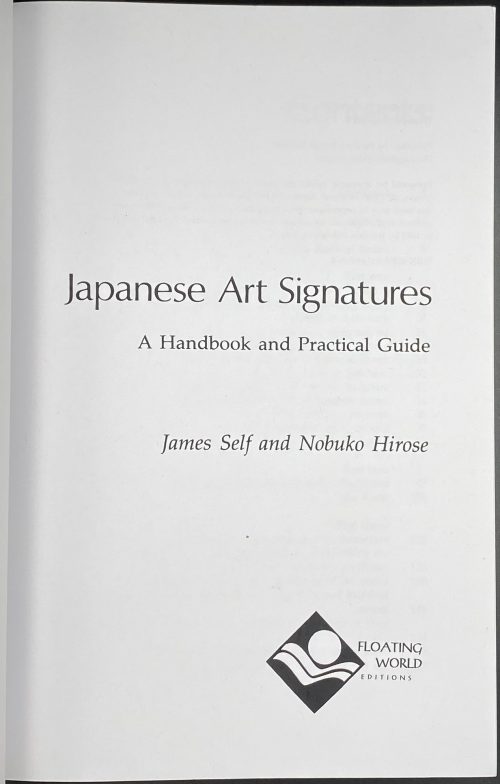 Title: Japanese Art Signatures | A Handbook and Practical Guide | James Self and Nobiko Hirose | {publisher’s device} FLOATING | WORLD | EDITIONS || Pp.: [2] 3-399 [400]. 1st Floating World edition, 2003, 3rd printing, 2011. 1st edition in 1987 by Bamboo Publishing, Ltd. by Charles E. Tuttle Company, Rutland and Tokyo. Binding: Original blue wrappers with white lettering to both covers and spine, in yellow frames.
Title: Japanese Art Signatures | A Handbook and Practical Guide | James Self and Nobiko Hirose | {publisher’s device} FLOATING | WORLD | EDITIONS || Pp.: [2] 3-399 [400]. 1st Floating World edition, 2003, 3rd printing, 2011. 1st edition in 1987 by Bamboo Publishing, Ltd. by Charles E. Tuttle Company, Rutland and Tokyo. Binding: Original blue wrappers with white lettering to both covers and spine, in yellow frames. -
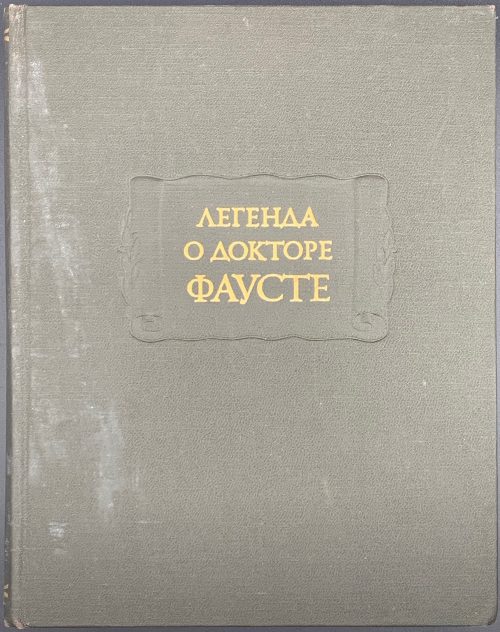 Title (black lettering, red elements): ЛЕГЕНДА | О ДОКТОРЕ | ФАУСТЕ | {element} | ИЗДАНИЕ ПОДГОТОВИЛ | В. М. ЖИРМУНСКИЙ | ВТОРОЕ, ИСПРАВЛЕННОЕ ИЗДАНИЕ | ИЗДАТЕЛЬСТВО «НАУКА» | МОСКВА 1978 || Pagination:[1-5] 6-421 [3]; +3 leaves of plates. Collation: 8vo; [1]8 2-278. Binding: 22 x 17.5 cm, serial green buckram blind-stamped with a scroll adorned with gold lettering to board and spine. Contents:
Title (black lettering, red elements): ЛЕГЕНДА | О ДОКТОРЕ | ФАУСТЕ | {element} | ИЗДАНИЕ ПОДГОТОВИЛ | В. М. ЖИРМУНСКИЙ | ВТОРОЕ, ИСПРАВЛЕННОЕ ИЗДАНИЕ | ИЗДАТЕЛЬСТВО «НАУКА» | МОСКВА 1978 || Pagination:[1-5] 6-421 [3]; +3 leaves of plates. Collation: 8vo; [1]8 2-278. Binding: 22 x 17.5 cm, serial green buckram blind-stamped with a scroll adorned with gold lettering to board and spine. Contents:- Исторические и легендарные свидетельства о докторе Фаусте / Пер. С. А. Акулянц.
- Народная книга: История о докторе Иоганне Фаусте, знаменитом чародее и чернокнижнике / Пер. Р. В. Френкель.
- Свидетельства о постановке народной драмы и кукольной комедии / Пер. С. А. Акулянц
- Кукольные комедии / Пер. H. A. Сигал: (1) Доктор Иоганн Фауст; (2) Доктор Фауст, или Великий Негромант; (3) Иоганнес Фауст.
- Кристофер Марло. Трагическая история доктора Фауста / Пер. H. H. Амосовой.
- «Фауст» Лессинга / Пер. В. Е. Гаккель-Аренс.
- Комментарии: В. М. Жирмунский. История легенды о Фаусте.
- Примечания / Сост. В. М. Жирмунский; к «Фаусту» Марло — H. H. Амосова.
-
![[Charles Octave Moget, Joseph Décembre]. Sempronius. Histoire de la Commune de Paris en 1871. Paris, Décembre-Alonnier, [1871]. – pp: [i, ii - ht, imprim.] iii, iv - t.p., blank] [v - table] vi-viii (viii numbered iii), [1] 2 [3] 4-267 [268 blank] [1] 2-12 advert. [Pseudonym of Charles Octave Moget and Joseph Décembre]. Charles Octave Moget, dit Octave Féré (1815-1875); Joseph Décembre, dit Décembre-Allonier (1836 – 1906).](https://varshavskycollection.com/wp-content/uploads/2021/02/LIB-2445.2020-a-1-500x745.jpeg) Front publisher’s yellow wrapper, in a double frame: SEMPRONIUS | HISTOIRE | DE LA | COMMUNE DE PARIS | EN 1871 | La période impériale. – La Révolution du 4 Septembre. – Le | gouvernement de la Défense nationale. – Le Parti républicain | et le Parti socialiste. – L'Association internationale des | travailleurs. – Menées du parti socialiste. – La Commune en 1793. – Le 31 octobre et le 22 janvier. – La Capitulation de | Paris. – Le 18 mars. – L'Assassinat des généraux Clément | Thomas et Lecomte. – Le Comité central de la Garde nationale. | – La Commune ; – Ses Agissement. – Son Budget. – La | Terreur. – Insolence des Fédérés. – Les journaux. – Les Otages. | – Les Opérations militaires. – Les Fusillades. – Les Vols. – Les | Barricades. – Les Incendies. – Documents officiels de la Commune. | TROISIÈME ÉDITION | PARIS, DECEMBRE - ALONNIER, LIBRAIRE-ÉDITEUR | 20 RUE SEGUR, 20 | PRÉS DE LA PLACE SAINT-ANDR -DES-ARTS || Title page: similar to the cover with no frame. Pagination: front wrapper, [2] – h.t. / imprint., [2] – t.p. / blank, [i] – table de matières, vi (i.e. ii), vii (i.e. iii), iii (i.e. iv), [1] 2-267 [268 blank], [1] 2-12 – publisher's advert., back wrapper. Collation : 18mo ; π4, 1-1518, ß6. Binding: 18.5 x 12 cm; softcover; original yellow wrappers, black lettering to covers and spine; almost disbound. Réferences: Le Quillec (1997): 2324; University of Sussex > Paris Commune Collection. Author of the book: "SEMPRONIUS" was in reality two men: Moget, Charles Octave [Féré, Octave] (French, 1815 – 1875) and Décembre, Joseph [Décembre-Allonier] (French, 1836 – 1906).
Front publisher’s yellow wrapper, in a double frame: SEMPRONIUS | HISTOIRE | DE LA | COMMUNE DE PARIS | EN 1871 | La période impériale. – La Révolution du 4 Septembre. – Le | gouvernement de la Défense nationale. – Le Parti républicain | et le Parti socialiste. – L'Association internationale des | travailleurs. – Menées du parti socialiste. – La Commune en 1793. – Le 31 octobre et le 22 janvier. – La Capitulation de | Paris. – Le 18 mars. – L'Assassinat des généraux Clément | Thomas et Lecomte. – Le Comité central de la Garde nationale. | – La Commune ; – Ses Agissement. – Son Budget. – La | Terreur. – Insolence des Fédérés. – Les journaux. – Les Otages. | – Les Opérations militaires. – Les Fusillades. – Les Vols. – Les | Barricades. – Les Incendies. – Documents officiels de la Commune. | TROISIÈME ÉDITION | PARIS, DECEMBRE - ALONNIER, LIBRAIRE-ÉDITEUR | 20 RUE SEGUR, 20 | PRÉS DE LA PLACE SAINT-ANDR -DES-ARTS || Title page: similar to the cover with no frame. Pagination: front wrapper, [2] – h.t. / imprint., [2] – t.p. / blank, [i] – table de matières, vi (i.e. ii), vii (i.e. iii), iii (i.e. iv), [1] 2-267 [268 blank], [1] 2-12 – publisher's advert., back wrapper. Collation : 18mo ; π4, 1-1518, ß6. Binding: 18.5 x 12 cm; softcover; original yellow wrappers, black lettering to covers and spine; almost disbound. Réferences: Le Quillec (1997): 2324; University of Sussex > Paris Commune Collection. Author of the book: "SEMPRONIUS" was in reality two men: Moget, Charles Octave [Féré, Octave] (French, 1815 – 1875) and Décembre, Joseph [Décembre-Allonier] (French, 1836 – 1906). -
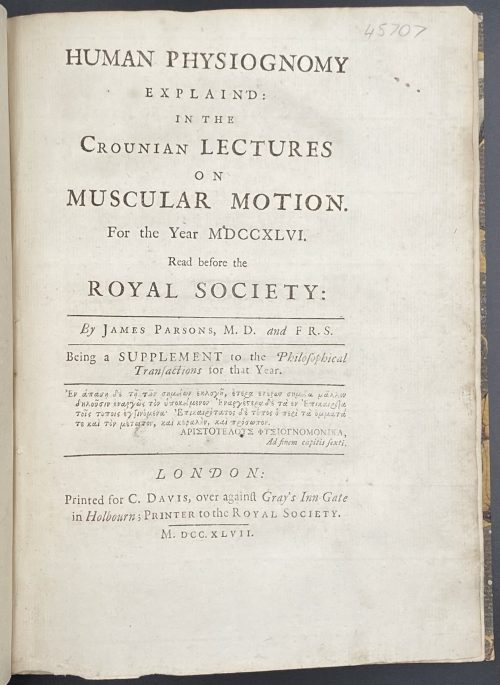 HUMAN PHYSIOGNOMY | EXPLAIN'D: | IN THE | Crounian LECTURES | ON MUSCULAR MOTION. | For the Year MDCCXLVI. | Read before the | ROYAL SOCIETY: | By James Parsons, M.D. and F.R.S. | Being a SUPPLEMENT to the Philosophical | Transactions for that Year. | {Citation in the Greek from Aristotle, 6 lines} | LONDON: | Printed for C. Davis, over against Gray's Inn Gate | in Holbourn; Printer to the Royal Society. | M. DCC. XLVII. || Pagination: [4] i-viii [8] 1-82 [4]; collation: 4to; [a]4 b4 c2 <inset> B-L4 M3, wanting 1 leaf with An Index For the Lectures of the Years 1744, and 1745; Inset: 5 folding plates engraved by J. Mynde after J. Parsons ('I. Ps. MD del.'). Page 22.5 x 16.5 cm; plates 22.5 x 34 cm. Printed on laid paper, with tall "s". Binding: 23 x 17 cm, modern hardcover in marbled paper, modern endpapers, white paper label with black lettering to spine. Crounian Lectures (i.e. Croonian Lectures), named after William Croone (British, 1633 – 1684). Contributors: James Parsons (British, 1705 – 1770). James Mynde (British, 1702 – 1771). Davis, Printer to the Royal Society of London (British, 1665 – 1775). Ref.: Royal Academy, The Royal Society, Wellcome Collection.
HUMAN PHYSIOGNOMY | EXPLAIN'D: | IN THE | Crounian LECTURES | ON MUSCULAR MOTION. | For the Year MDCCXLVI. | Read before the | ROYAL SOCIETY: | By James Parsons, M.D. and F.R.S. | Being a SUPPLEMENT to the Philosophical | Transactions for that Year. | {Citation in the Greek from Aristotle, 6 lines} | LONDON: | Printed for C. Davis, over against Gray's Inn Gate | in Holbourn; Printer to the Royal Society. | M. DCC. XLVII. || Pagination: [4] i-viii [8] 1-82 [4]; collation: 4to; [a]4 b4 c2 <inset> B-L4 M3, wanting 1 leaf with An Index For the Lectures of the Years 1744, and 1745; Inset: 5 folding plates engraved by J. Mynde after J. Parsons ('I. Ps. MD del.'). Page 22.5 x 16.5 cm; plates 22.5 x 34 cm. Printed on laid paper, with tall "s". Binding: 23 x 17 cm, modern hardcover in marbled paper, modern endpapers, white paper label with black lettering to spine. Crounian Lectures (i.e. Croonian Lectures), named after William Croone (British, 1633 – 1684). Contributors: James Parsons (British, 1705 – 1770). James Mynde (British, 1702 – 1771). Davis, Printer to the Royal Society of London (British, 1665 – 1775). Ref.: Royal Academy, The Royal Society, Wellcome Collection. -
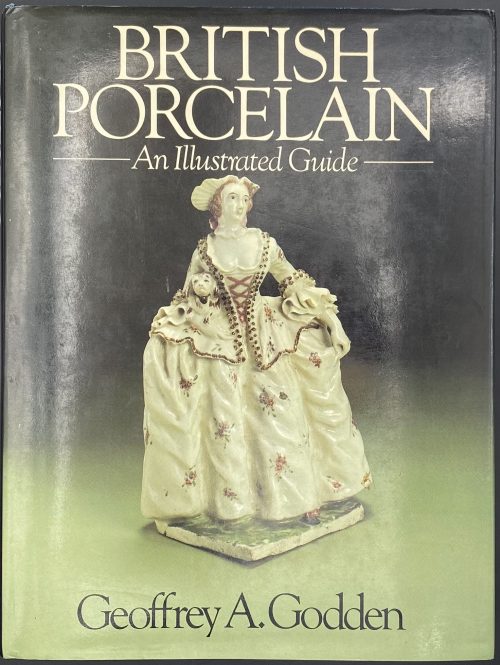 Hardcover in blue cloth with gilt lettering to spine, pictorial dust jacket, 25.5 x 19.5 cm, pp.: [1-4] 5-452, +12 colour plates; 576 b/w plates within the pagination.
Hardcover in blue cloth with gilt lettering to spine, pictorial dust jacket, 25.5 x 19.5 cm, pp.: [1-4] 5-452, +12 colour plates; 576 b/w plates within the pagination. -
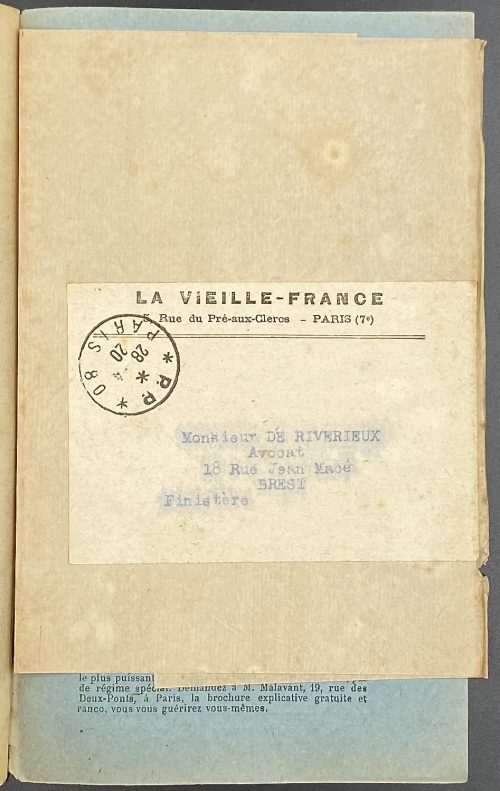 50 issues (full 1920 year) of the French anti-Semitic journal La Vieille France published by Urbain Gohier in Paris from 1916 to 1924. LIB-LIB-2731-1.2021 to LIB-2731-50.2021.
50 issues (full 1920 year) of the French anti-Semitic journal La Vieille France published by Urbain Gohier in Paris from 1916 to 1924. LIB-LIB-2731-1.2021 to LIB-2731-50.2021. -
![Оммер де Гелль [псевд. П. П. Вяземского]. Письма и записки. / Ред., вступ. ст. и прим. М. М. Чистяковой. Оформ. Н. П. Дмитриевского. // Серия: «Иностранные мемуары». Под общ. ред. И. Т. Смилги. — М.-Л.: Academia, 1933. — 469 стр., 8 л. илл., суперобложка. Тираж 5300 экз.](https://varshavskycollection.com/wp-content/uploads/2021/02/LIB-1930.2019-a-500x647.jpeg) Frontispiece: ИНОСТРАННЫЕ МЕМУАРЫ Под общей редакцией | И. Т. Смилги | ОММЕР ДЕ ГЕЛЛЬ | «Academia» | Москва—Ленинград || Title page: ОММЕР ДЕ ГЕЛЛЬ | ПИСЬМА и ЗАПИСКИ | Редакция, вступительная статья и примечания| М. М. Чистяковой | ACADEMIA | 1933 || Title verso: Супер-обложка и переплет | по рисункам Н. П. Дмитревского || Pagination: [1-6] 7-464 [8], ill. Collation: 8vo; [1]-298, 304 + 8 plates (photomechanical), one of them folded. Binding: 17.5 x 13.5 cm, original purple cloth, white lettering to spine, vignette to front board, pictorial DJ. Print run: 5300 copies. Catalogue raisonné: Крылов-Кичатова (2004): № 564, p.236. Вяземский, Павел Петрович (Russian, 1820 – 1888) – author. A famous literary forgery and mystification in the history of Russian literature. The fictitious author – Оммер де Гелль – was an existing human being: Adèle Hommaire de Hell, née Hériot (French, 1819 — 1883), a French writier. The fictitious matter of the book was not proven before 1935. The details can be found here.
Frontispiece: ИНОСТРАННЫЕ МЕМУАРЫ Под общей редакцией | И. Т. Смилги | ОММЕР ДЕ ГЕЛЛЬ | «Academia» | Москва—Ленинград || Title page: ОММЕР ДЕ ГЕЛЛЬ | ПИСЬМА и ЗАПИСКИ | Редакция, вступительная статья и примечания| М. М. Чистяковой | ACADEMIA | 1933 || Title verso: Супер-обложка и переплет | по рисункам Н. П. Дмитревского || Pagination: [1-6] 7-464 [8], ill. Collation: 8vo; [1]-298, 304 + 8 plates (photomechanical), one of them folded. Binding: 17.5 x 13.5 cm, original purple cloth, white lettering to spine, vignette to front board, pictorial DJ. Print run: 5300 copies. Catalogue raisonné: Крылов-Кичатова (2004): № 564, p.236. Вяземский, Павел Петрович (Russian, 1820 – 1888) – author. A famous literary forgery and mystification in the history of Russian literature. The fictitious author – Оммер де Гелль – was an existing human being: Adèle Hommaire de Hell, née Hériot (French, 1819 — 1883), a French writier. The fictitious matter of the book was not proven before 1935. The details can be found here. -
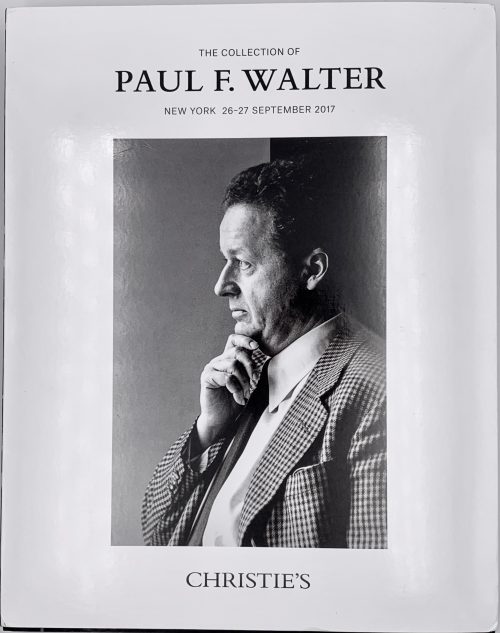 Christie's Auction Catalog; Sale WALTER-15785; New York, September 26-27, 2017; Publisher's pictorial wrappers, front cover: THE COLLECTION OF | PAUL F. WALTER | NEW YORK 26–27 SEPTEMBER 2917 | {profile chest portrait of Paul F. Walter} | CHRISTIE'S || 26.8 x 21.2 x 3 cm; 662 lots, illustrations in colour and b/w, pictorial dust jacket; pp: [2] 3-462.
Christie's Auction Catalog; Sale WALTER-15785; New York, September 26-27, 2017; Publisher's pictorial wrappers, front cover: THE COLLECTION OF | PAUL F. WALTER | NEW YORK 26–27 SEPTEMBER 2917 | {profile chest portrait of Paul F. Walter} | CHRISTIE'S || 26.8 x 21.2 x 3 cm; 662 lots, illustrations in colour and b/w, pictorial dust jacket; pp: [2] 3-462.Paul F. Walter (American, 1935 – 2017) – "Collector. Following studies in history and history of art Oberlin College, Ohio, and Columbia University, he began to collect in the1960s, starting with prints by Whistler and moving on to the Aesthetic Movement and the Arts & Crafts in Britain, as well as the arts of the Indian subcontinent and modern American painting. He was Trustee of the Museum of Modern Art from 1992-2006, and a benefactor to the Metropolitan Museum of Art, the Cooper-Hewitt Design Museum, the Morgan Library and Museum, the Brooklyn Museum, the Allen Memorial Art Museum at Oberlin College, and the Los Angeles County Museum of Art."
-
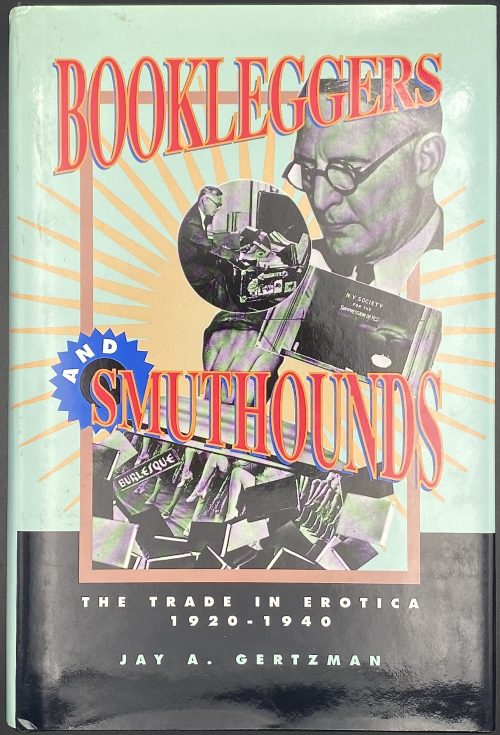 Title page: BOOKLEGGERS | AND | SMUTHOUNDS | THE TRADE IN EROTICA, 1920-1940 | JAY A. GERTZMAN | UNIVERSITY OF PENNSYLVANIA PRESS • PHILADELPHIA || Pagination: [8] [1] 2-418 [6] blanks, total 216 leaves. Binding: 24.5 x 16 cm; black cloth, silver lettering to spine, pictorial dust jacket.
Title page: BOOKLEGGERS | AND | SMUTHOUNDS | THE TRADE IN EROTICA, 1920-1940 | JAY A. GERTZMAN | UNIVERSITY OF PENNSYLVANIA PRESS • PHILADELPHIA || Pagination: [8] [1] 2-418 [6] blanks, total 216 leaves. Binding: 24.5 x 16 cm; black cloth, silver lettering to spine, pictorial dust jacket. -
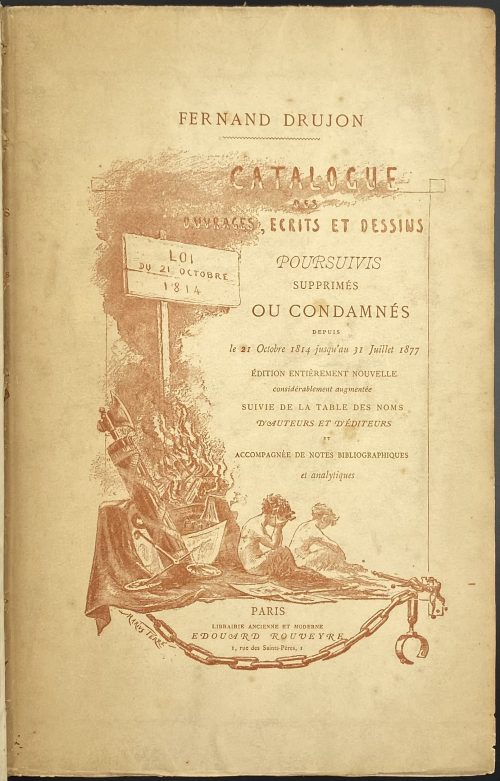 Title page: CATALOGUE | DES | OUVRAGES, ÉCRITS | ET DESSINS | DE TOUTE NATURE | POURSUIVIS, SUPPRIMÉS OU CONDAMNÉS | DEPUIS LE 21 OCTOBRE 1814 JUSQU'AU 31 JUILLET 1877 | Edition entièrement nouvelle, considérablement augmentée | SUIVIE DE LA TABLE DES NOMS D’AUTEURS ET D’ÉDITEURS | ET ACCOMPAGNÉE DE NOTES BIBLIOGRAPHIQUES ET ANALYTIQUES | PAR | FERNAND DRUJON | {publisher’s device} | PARIS | LIBRAIRIE ANCIENNE ET MODERNE | ÉDOUARD ROUVEYRE | 1, RUE DES SAINTS-PÈRES, 1 | 1879 || Pagination: [2] [i-v] vi-xxxvii [xxxviii blank] [1] 2-430 [2] 1-16, total number of pages 2+38+430+2+16=488. Collation: 8vo; π4 i-ii8 1-258 26-294 ω8, total number of leaves 4+(2x8)+(25x8)+(4x4)+8=244; 2 binder’s blank leaves before the front wrapper, 2 blanks after the wrapper, blank / avis important, h.t. with gift inscription from publisher to Anger / limitation, t.p. / blank, [text], 17 leaves of advert., 2 blanks before back wrapper, 1 binder’s blank after. Binding: 28.3 x 19 cm, tree-quarter beige buckram over marbled boards, spine: brown leather label with gilt double fillet top and bottom, gilt lettering, stamped in gilt with a lily and a year of publishing, gilt double-fillet to tail; publisher’s wrappers bound in. Bookplate with motto “AGE DICANT” to front pastedown. Gift inscription: "À mon ami Anger | Hommage de me bien dévoué | Édouard Rouveyre". Possibly Pierre Anger (1854-19..).Contributors: Drujon, Fernand (French, 1845 – 1912) Rouveyre, Édouard (French, 1849 – 1930)Edition: 1st edition, this copy is from an unnumbered print run. Despite the note "Edition entièrement nouvelle, considérablement augmentée" this is obviously the 1st edition.
Title page: CATALOGUE | DES | OUVRAGES, ÉCRITS | ET DESSINS | DE TOUTE NATURE | POURSUIVIS, SUPPRIMÉS OU CONDAMNÉS | DEPUIS LE 21 OCTOBRE 1814 JUSQU'AU 31 JUILLET 1877 | Edition entièrement nouvelle, considérablement augmentée | SUIVIE DE LA TABLE DES NOMS D’AUTEURS ET D’ÉDITEURS | ET ACCOMPAGNÉE DE NOTES BIBLIOGRAPHIQUES ET ANALYTIQUES | PAR | FERNAND DRUJON | {publisher’s device} | PARIS | LIBRAIRIE ANCIENNE ET MODERNE | ÉDOUARD ROUVEYRE | 1, RUE DES SAINTS-PÈRES, 1 | 1879 || Pagination: [2] [i-v] vi-xxxvii [xxxviii blank] [1] 2-430 [2] 1-16, total number of pages 2+38+430+2+16=488. Collation: 8vo; π4 i-ii8 1-258 26-294 ω8, total number of leaves 4+(2x8)+(25x8)+(4x4)+8=244; 2 binder’s blank leaves before the front wrapper, 2 blanks after the wrapper, blank / avis important, h.t. with gift inscription from publisher to Anger / limitation, t.p. / blank, [text], 17 leaves of advert., 2 blanks before back wrapper, 1 binder’s blank after. Binding: 28.3 x 19 cm, tree-quarter beige buckram over marbled boards, spine: brown leather label with gilt double fillet top and bottom, gilt lettering, stamped in gilt with a lily and a year of publishing, gilt double-fillet to tail; publisher’s wrappers bound in. Bookplate with motto “AGE DICANT” to front pastedown. Gift inscription: "À mon ami Anger | Hommage de me bien dévoué | Édouard Rouveyre". Possibly Pierre Anger (1854-19..).Contributors: Drujon, Fernand (French, 1845 – 1912) Rouveyre, Édouard (French, 1849 – 1930)Edition: 1st edition, this copy is from an unnumbered print run. Despite the note "Edition entièrement nouvelle, considérablement augmentée" this is obviously the 1st edition. -
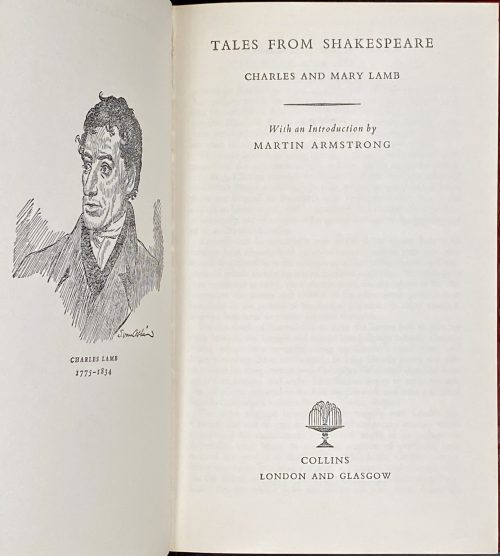 Title-page: TALES FROM SHAKESPEARE | CHARLES AND MARY LAMB | — | With an Introduction by | MARTIN ARMSTRONG | {space} | {publisher’s device} | COLLINS | LONDON AND GLASGOW || Pagination: [1-4] 5-256, frontispiece: reproduction of portrait of Charles Lamb. Edition: reprint of 1953 edition (WorldCat); in Collins Classics series. Binding: 18.5 x 11 cm, semi-soft, crimson faux morocco, blind-stamped fillet border, gilt lettering to spine, TEG, slipcase. Contributors: William Shakespeare (English, 1564 – 1616) Mary Ann Lamb (British, 1764 – 1847) – author. Charles Lamb (British, 1775 – 1834) – author. Collins Clear-Type Press & Publisher (London; Glasgow) – printer and publisher. Note: “On the writing desk were two books – identical copies of Lamb’s Tales From Shakespeare. […] — Why did you choose Lamb? — It was the only book I could find in duplicate except Uncle Tom’s Cabin…” Graham Greene. Our Man in Havana.
Title-page: TALES FROM SHAKESPEARE | CHARLES AND MARY LAMB | — | With an Introduction by | MARTIN ARMSTRONG | {space} | {publisher’s device} | COLLINS | LONDON AND GLASGOW || Pagination: [1-4] 5-256, frontispiece: reproduction of portrait of Charles Lamb. Edition: reprint of 1953 edition (WorldCat); in Collins Classics series. Binding: 18.5 x 11 cm, semi-soft, crimson faux morocco, blind-stamped fillet border, gilt lettering to spine, TEG, slipcase. Contributors: William Shakespeare (English, 1564 – 1616) Mary Ann Lamb (British, 1764 – 1847) – author. Charles Lamb (British, 1775 – 1834) – author. Collins Clear-Type Press & Publisher (London; Glasgow) – printer and publisher. Note: “On the writing desk were two books – identical copies of Lamb’s Tales From Shakespeare. […] — Why did you choose Lamb? — It was the only book I could find in duplicate except Uncle Tom’s Cabin…” Graham Greene. Our Man in Havana. -
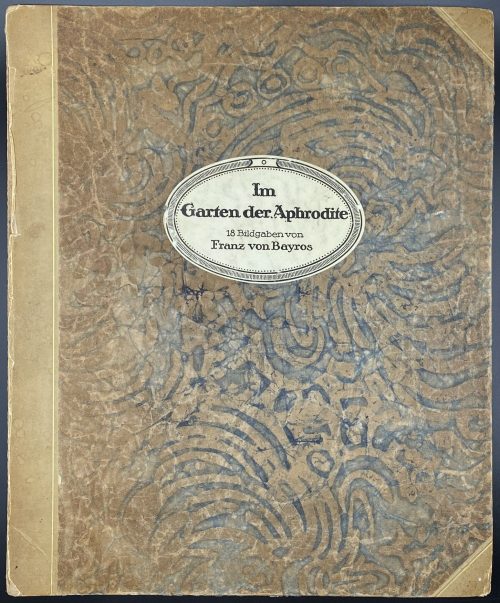 Cover with title: Im Garten der Aphrodite | 18 Bildgaben | von | Franz von Bayros | {vignette} | Privatdruck || in a frame; table of contents and limitation to verso; 18 plates with the drawings of Bayros in collotype reproduction, each mounted on cardboard and protected with the remnants of tissue guards, some lacking. Of the publisher’s folder, only the front board with an oval title label is present. Some images signed “Choisy le Conin” – von Bayros’s pseudonym. Two prints are missing: (1) Das Füßchen and (2) Die Liebesschaukel, the other 16 prints present. The vignette on the cover is a photomechanical reproduction. Edition: limited to 350 copies of which this is № 253. According to Christie’s: a collotype reprint, about twenty years after their first publication. English equivalent: The Garden of Aphrodite. Portfolio with 18 photogravures. Catalogue raisonné: The amorous drawings of the Marquis von Bayros (1968): pp. 177-1877; Bayros Zeichningen (1987): pp. 143-152.
Cover with title: Im Garten der Aphrodite | 18 Bildgaben | von | Franz von Bayros | {vignette} | Privatdruck || in a frame; table of contents and limitation to verso; 18 plates with the drawings of Bayros in collotype reproduction, each mounted on cardboard and protected with the remnants of tissue guards, some lacking. Of the publisher’s folder, only the front board with an oval title label is present. Some images signed “Choisy le Conin” – von Bayros’s pseudonym. Two prints are missing: (1) Das Füßchen and (2) Die Liebesschaukel, the other 16 prints present. The vignette on the cover is a photomechanical reproduction. Edition: limited to 350 copies of which this is № 253. According to Christie’s: a collotype reprint, about twenty years after their first publication. English equivalent: The Garden of Aphrodite. Portfolio with 18 photogravures. Catalogue raisonné: The amorous drawings of the Marquis von Bayros (1968): pp. 177-1877; Bayros Zeichningen (1987): pp. 143-152. -
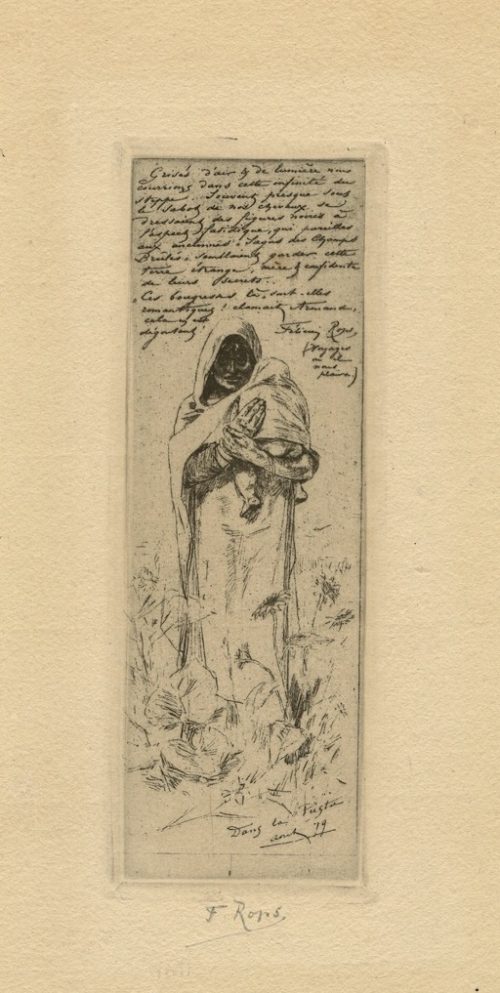
Etching and drypoint, signed in pencil by the artist under the plate; 2nd state. Pasted on a sheet of blue paper. Fragment of "La messe de Gnide". Owner's stamp 'LvM' on verso.
Dimensions: Blue paper: 32 x 27 cm; Laid paper: 30.7 x 22 cm; Image: 12.5 x 4 cm.
Catalogue raisonné: Arthur Hubschmid (1977): 364; Graphics irreverent and erotic (1968): 59; Rouir: 508.
-
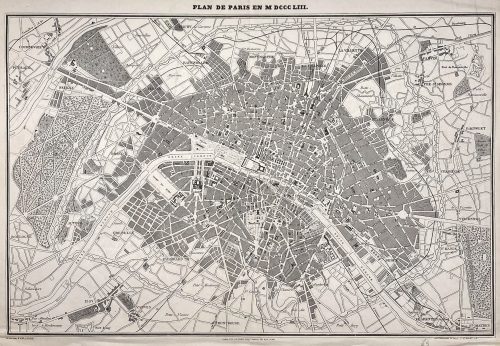 Above the frame: PLAN DE PARIS EN MDCCCLIII. Below the frame: Gravé par F. DELAMARE […] PARIS. TYP. DE FIRMIN DIDOT FRÈRES, 56, RUE JACOB. […] PANICONOGRAPHIE DE GILLOT. Q. ST. MICHEL 23. Dimensions: Sheet: 37 x 52.5 cm: Image: 33 x 50 cm. Technique: Photozincography Contributors: Ferdinand Théodore Delamare (French, fl. 1850 – 1889) – engraver. Firmin Didot Frères ; Firmin Didot (French, 1764 – 1836) – publisher. Firmin Gillot (French, 1819 – 1872) – printer.
Above the frame: PLAN DE PARIS EN MDCCCLIII. Below the frame: Gravé par F. DELAMARE […] PARIS. TYP. DE FIRMIN DIDOT FRÈRES, 56, RUE JACOB. […] PANICONOGRAPHIE DE GILLOT. Q. ST. MICHEL 23. Dimensions: Sheet: 37 x 52.5 cm: Image: 33 x 50 cm. Technique: Photozincography Contributors: Ferdinand Théodore Delamare (French, fl. 1850 – 1889) – engraver. Firmin Didot Frères ; Firmin Didot (French, 1764 – 1836) – publisher. Firmin Gillot (French, 1819 – 1872) – printer.


